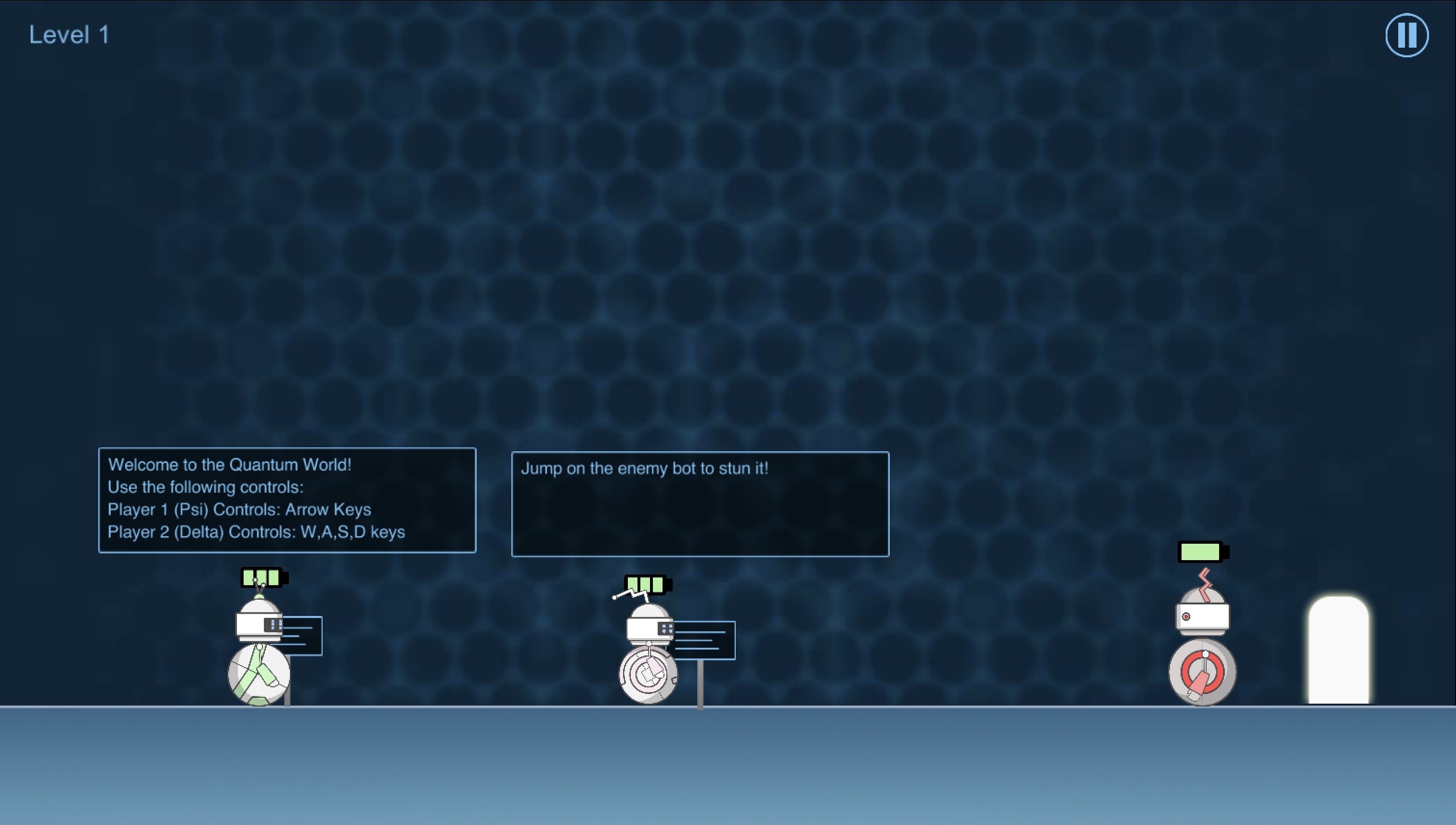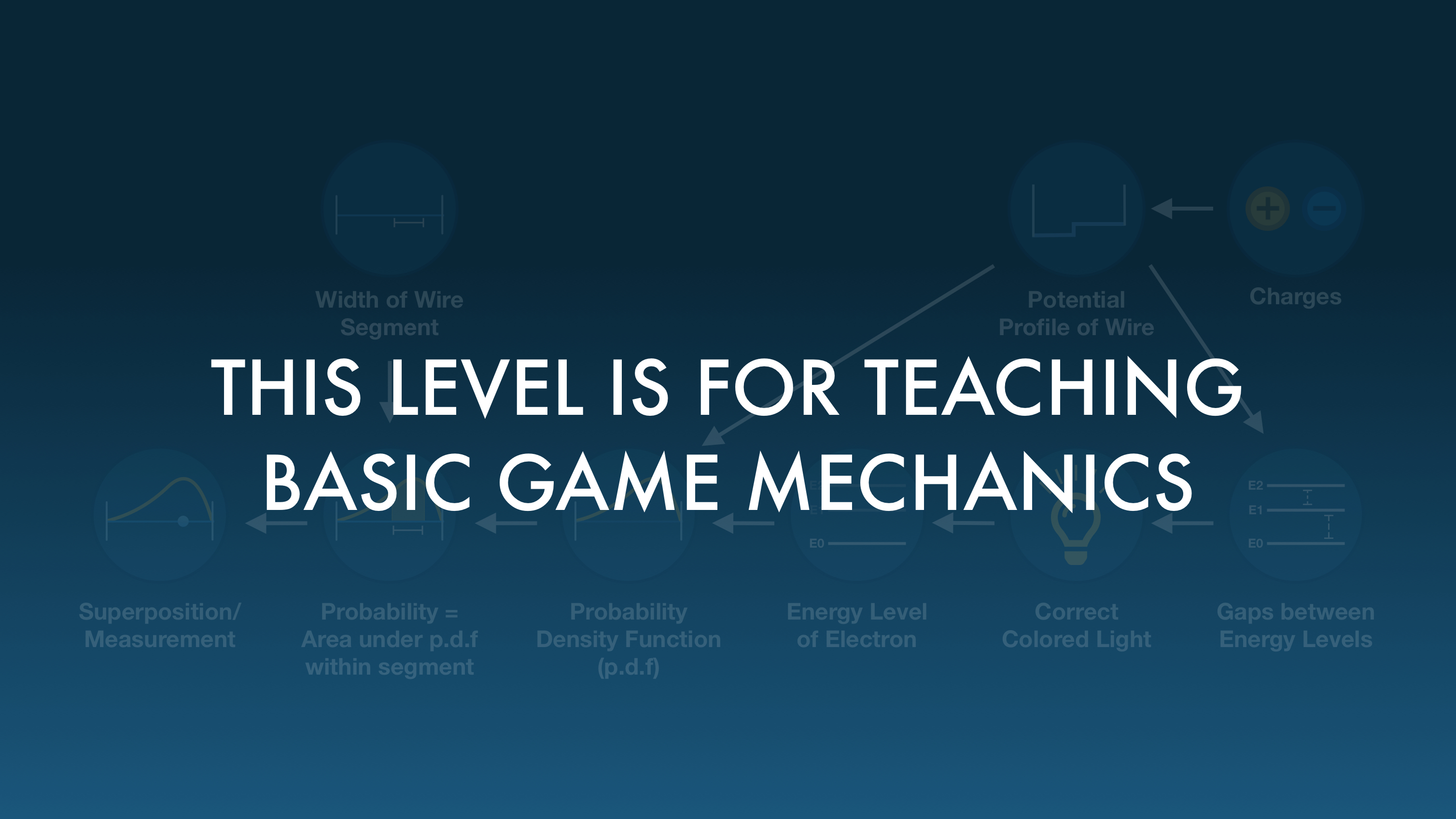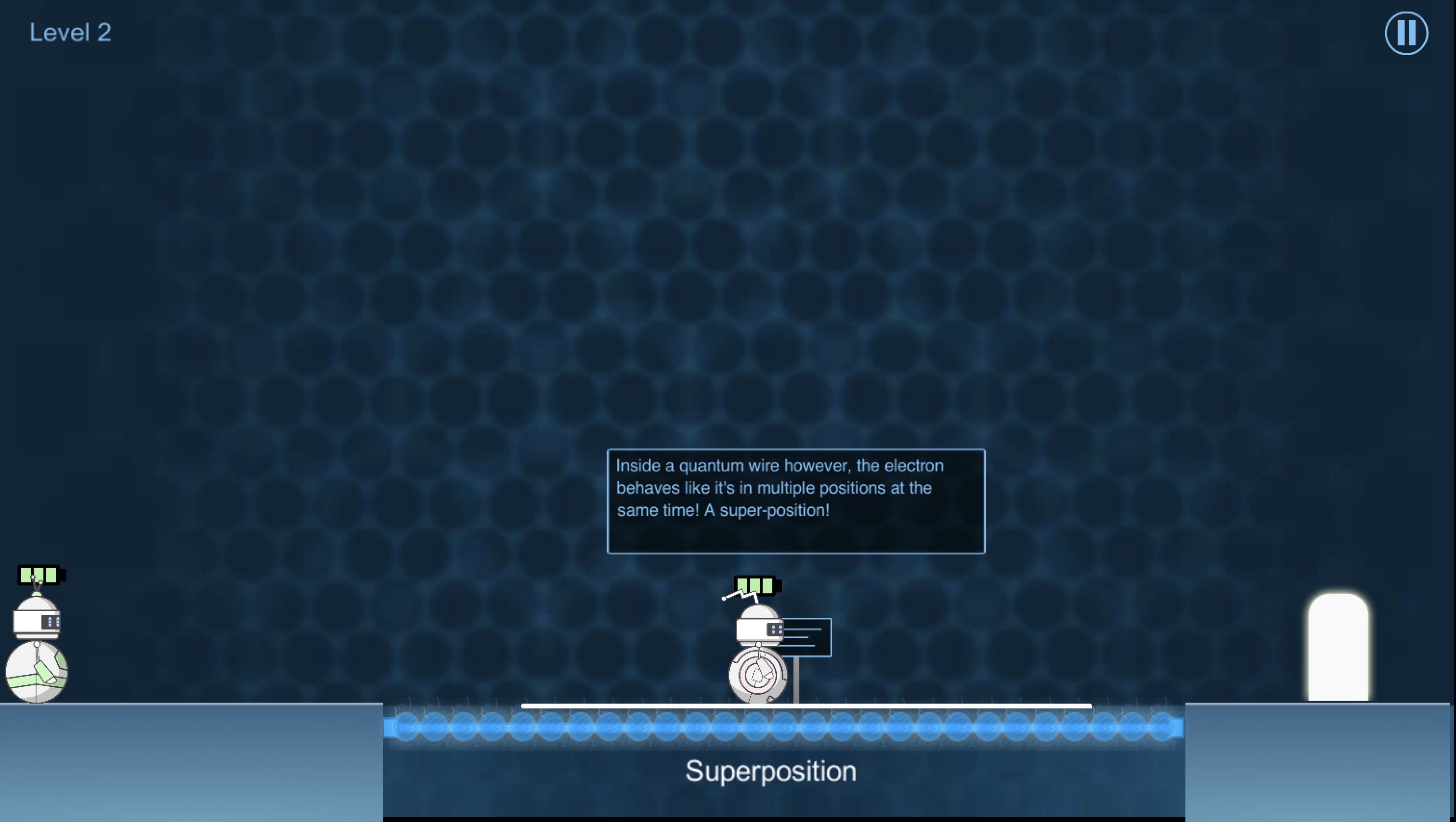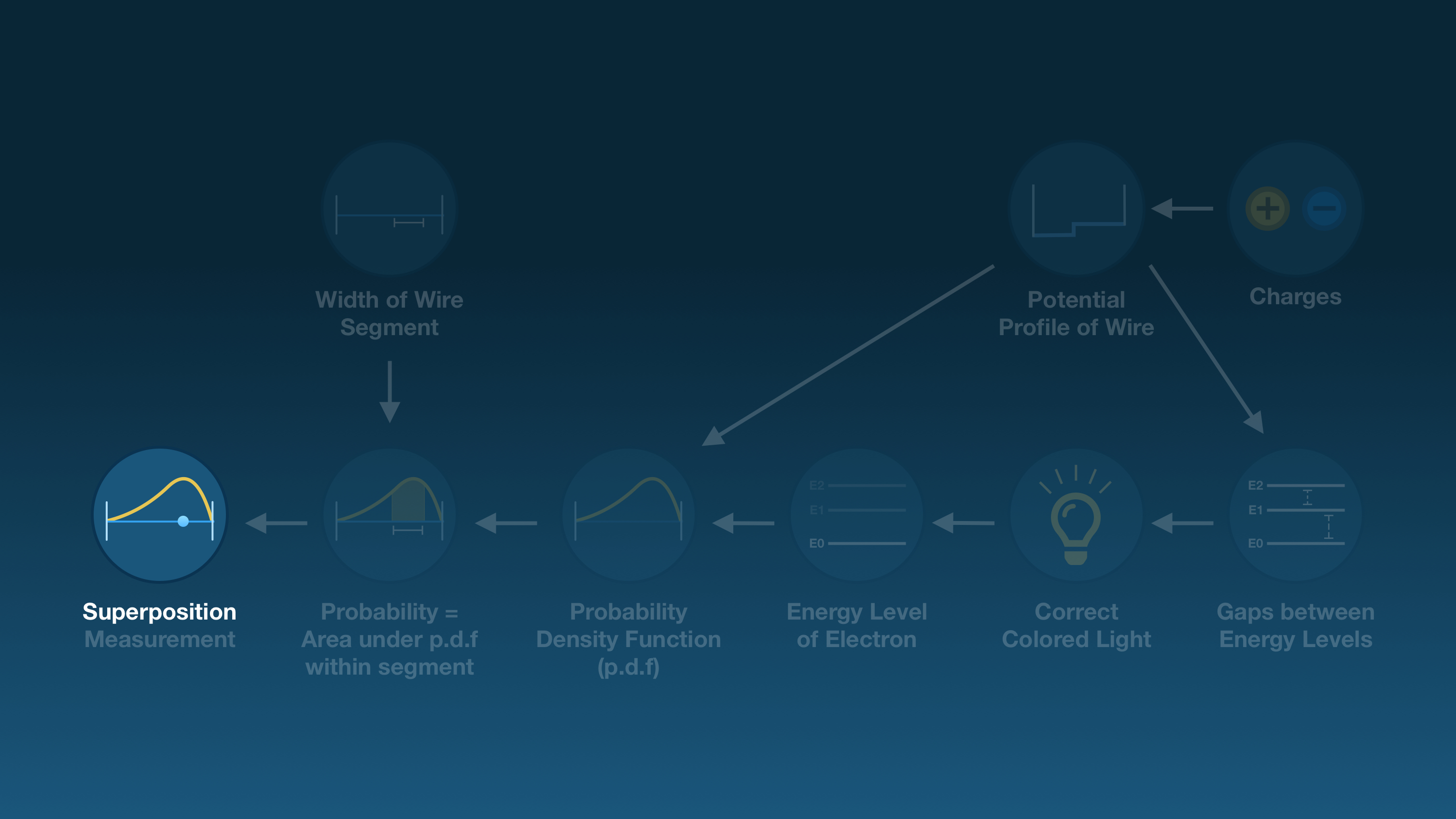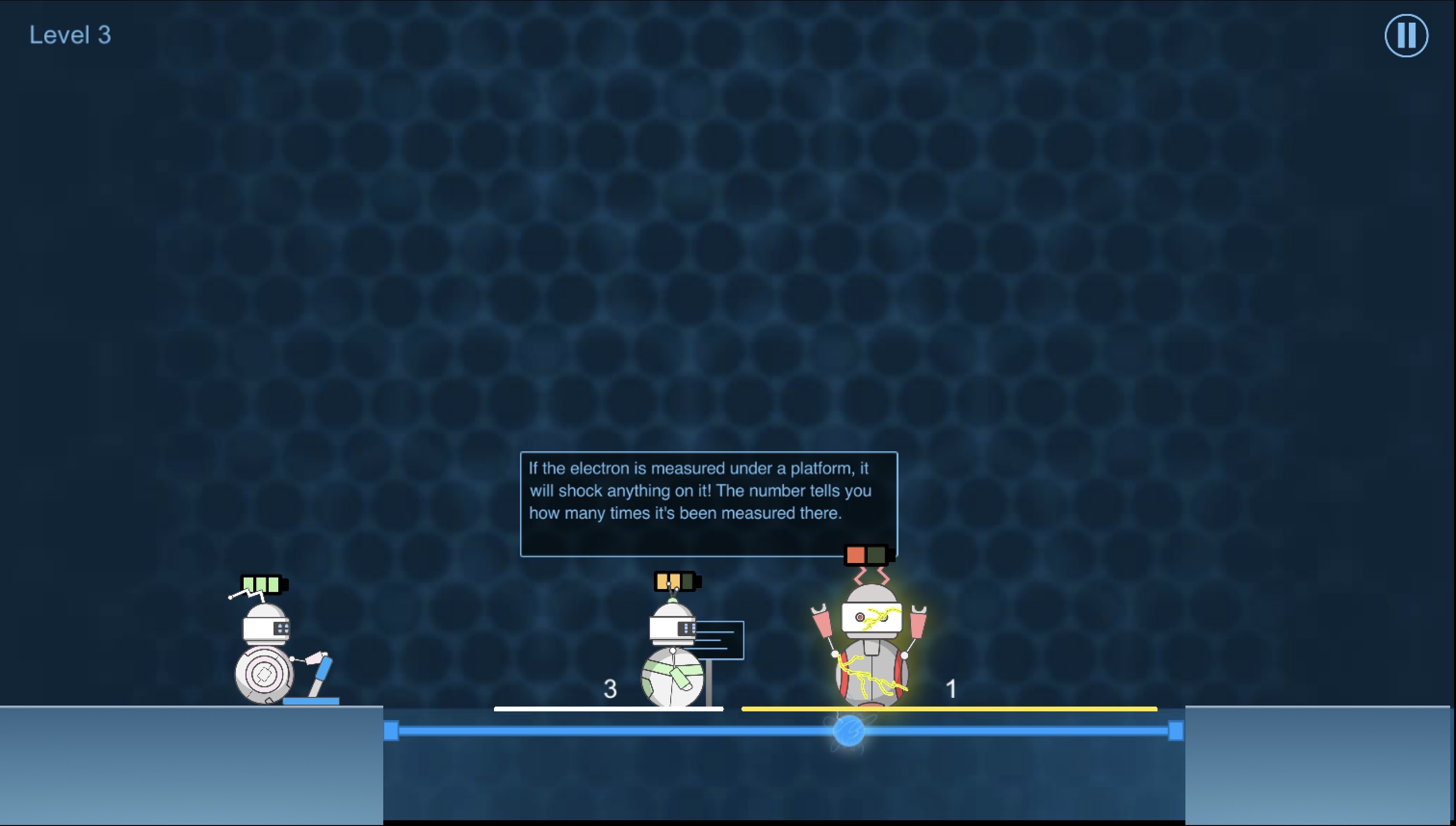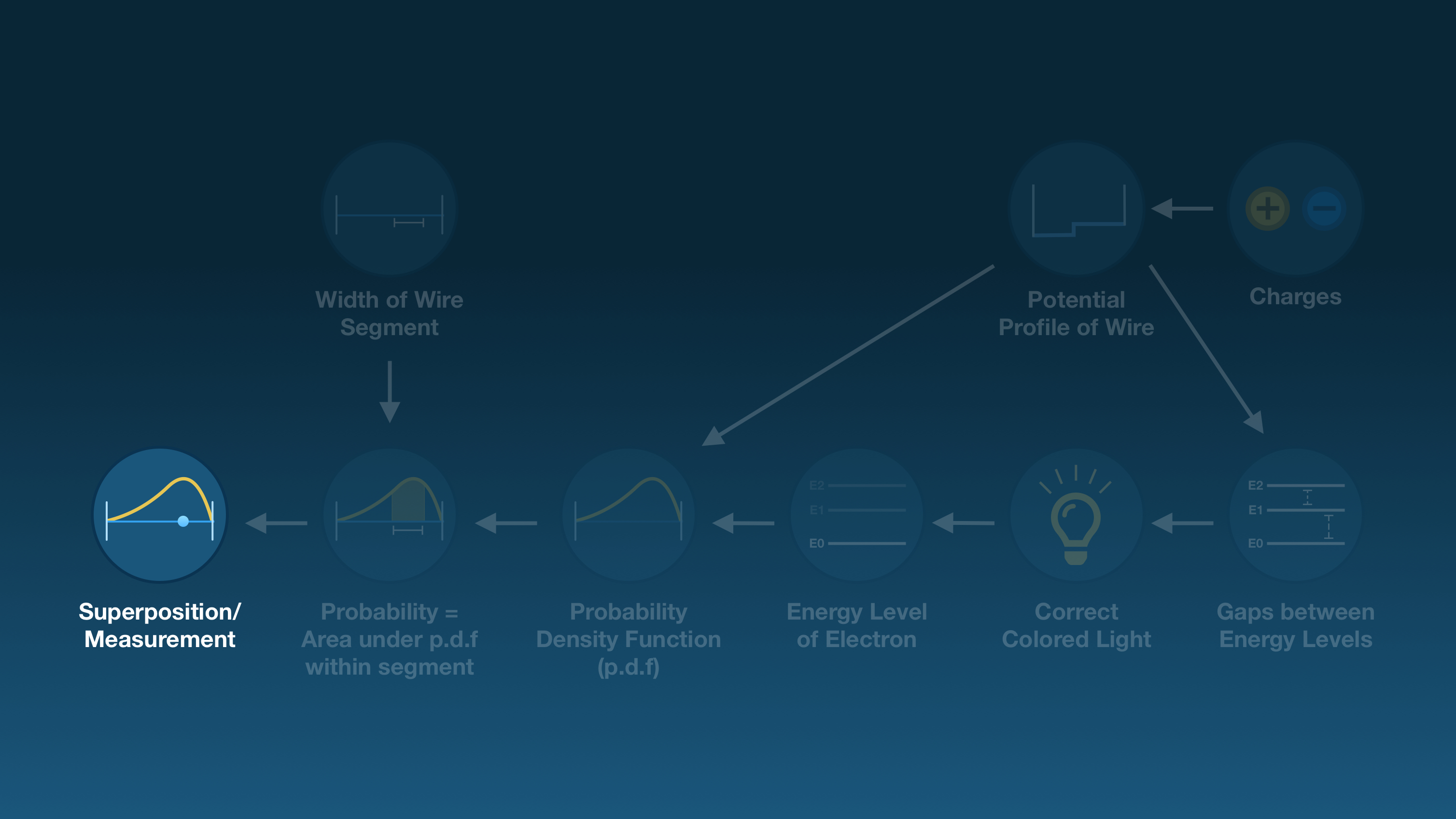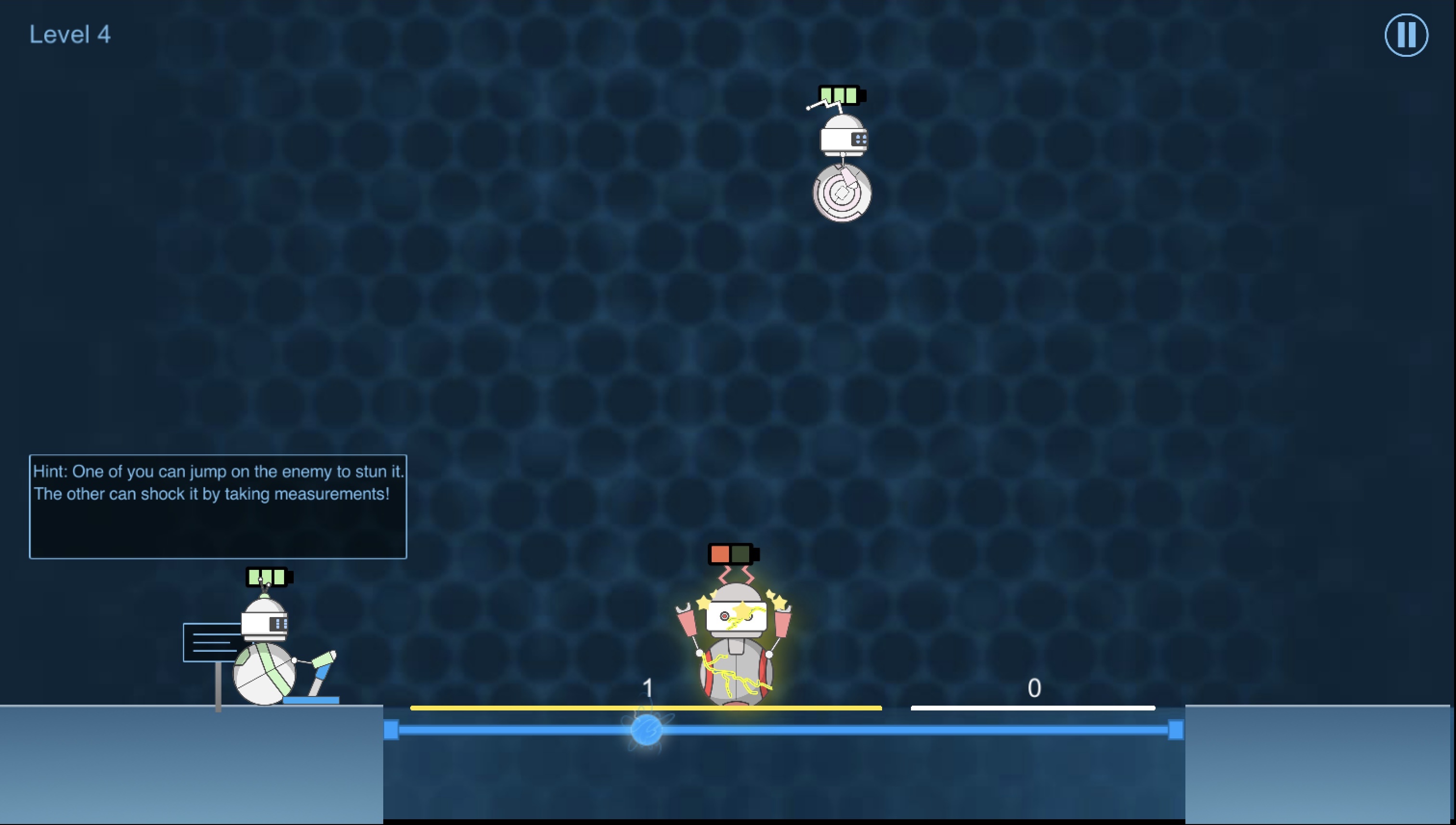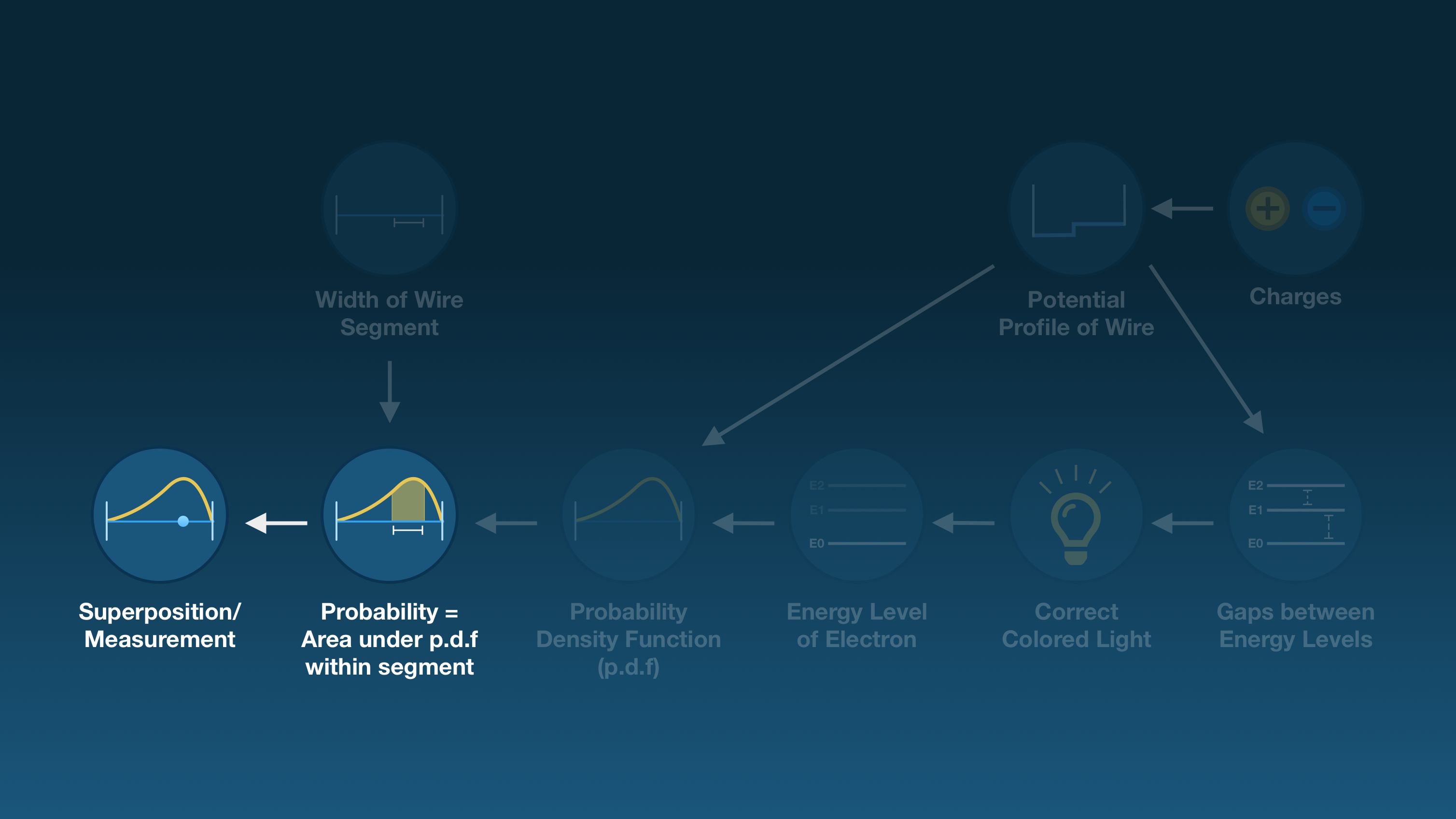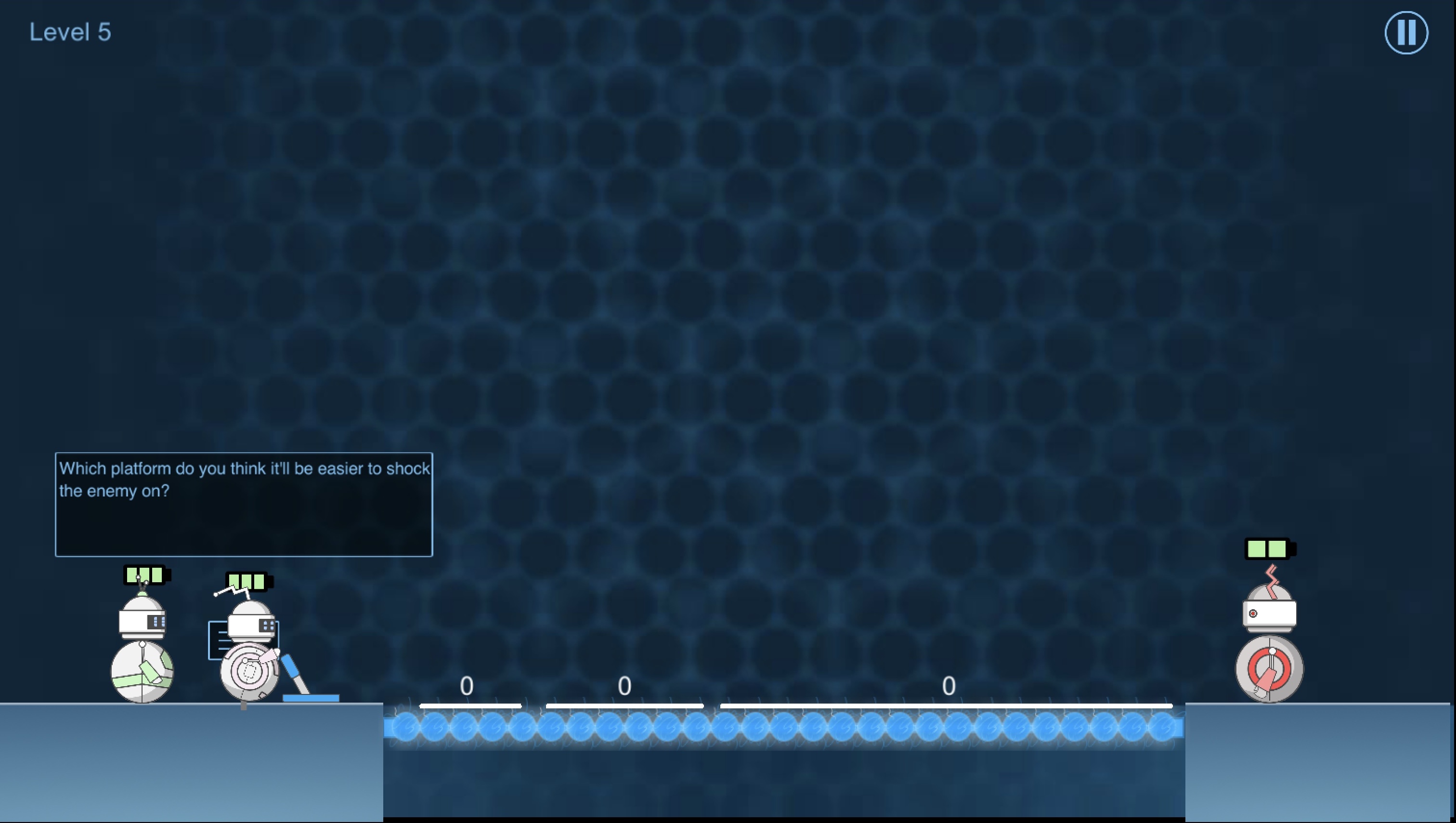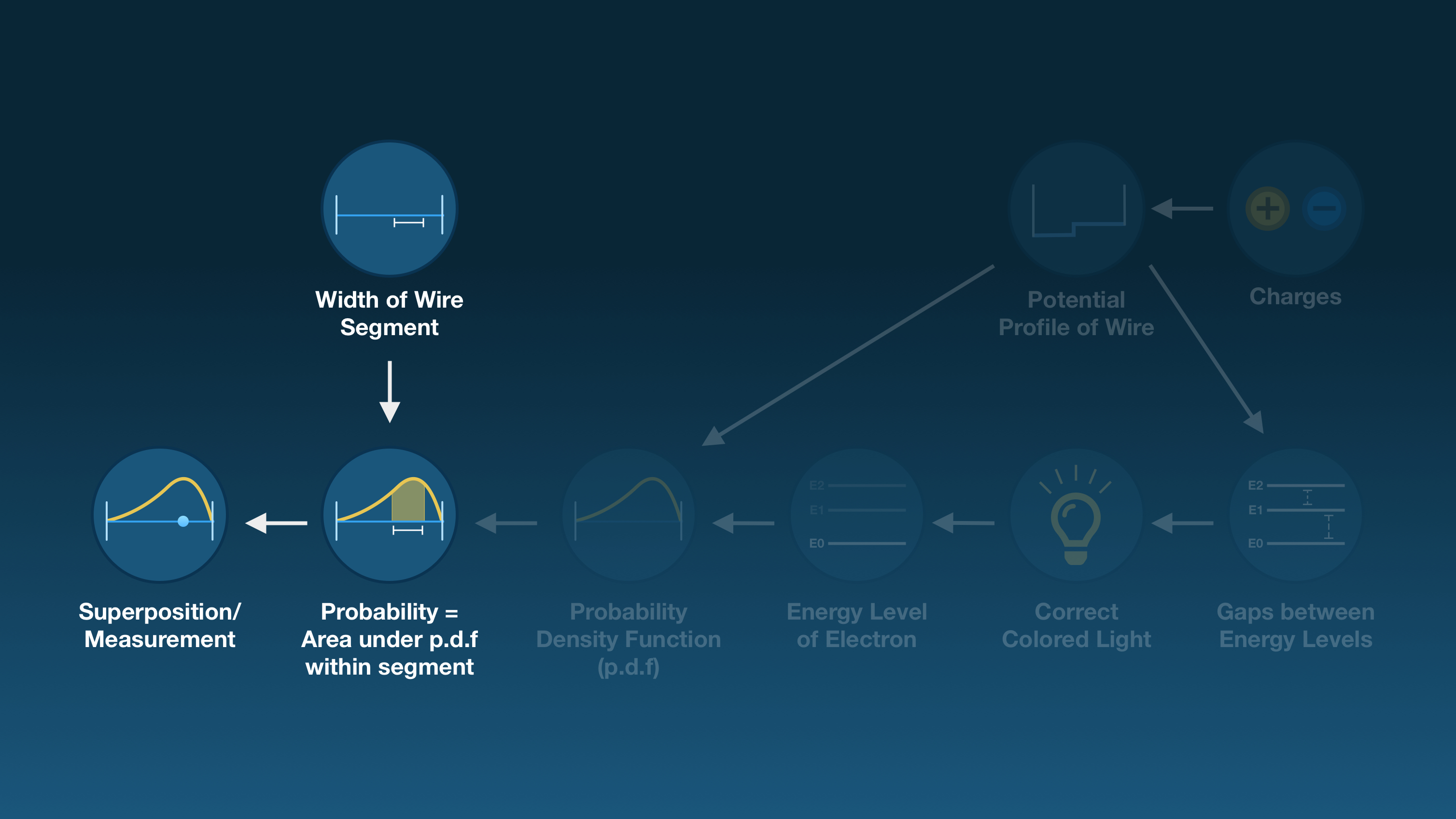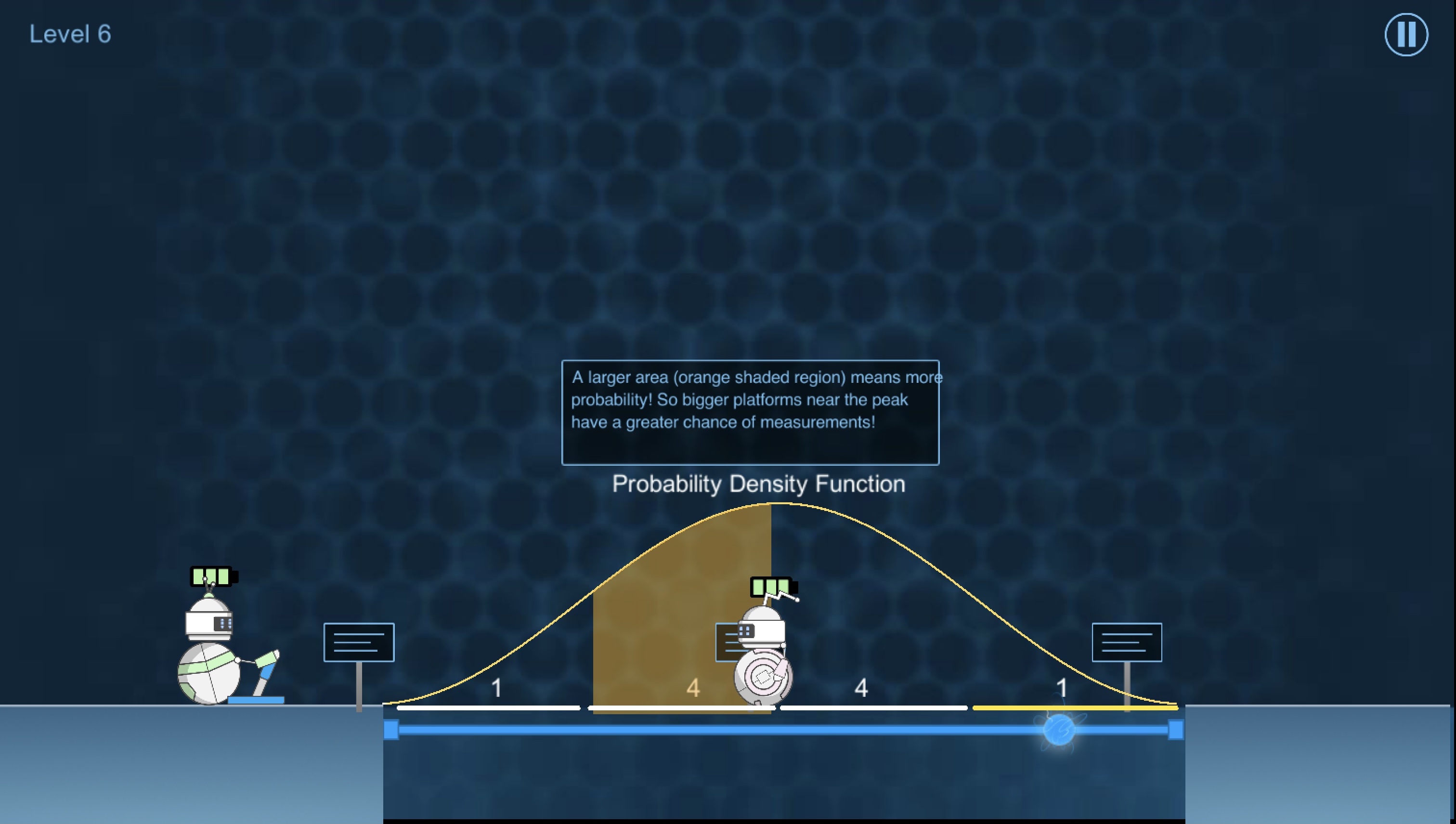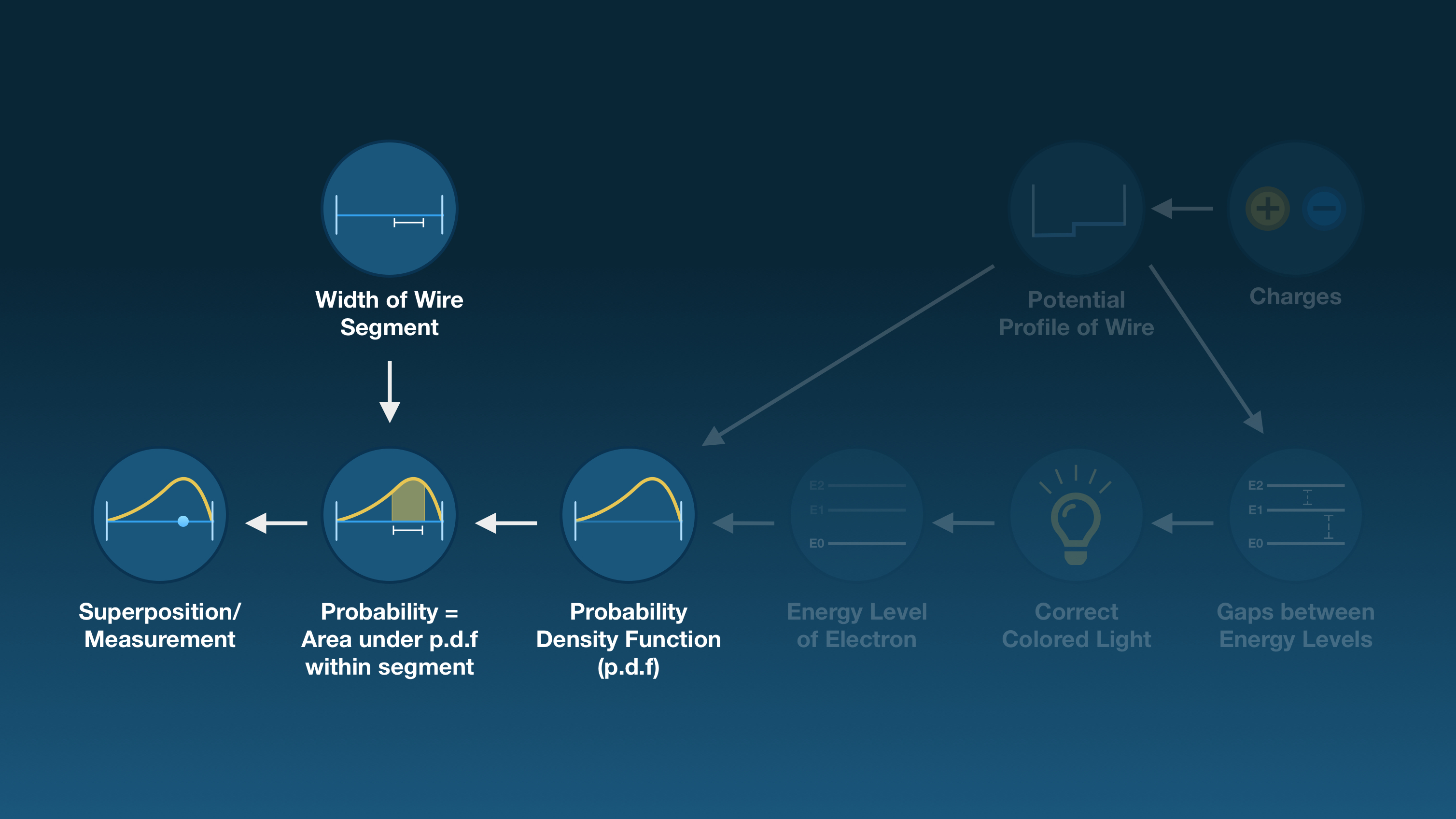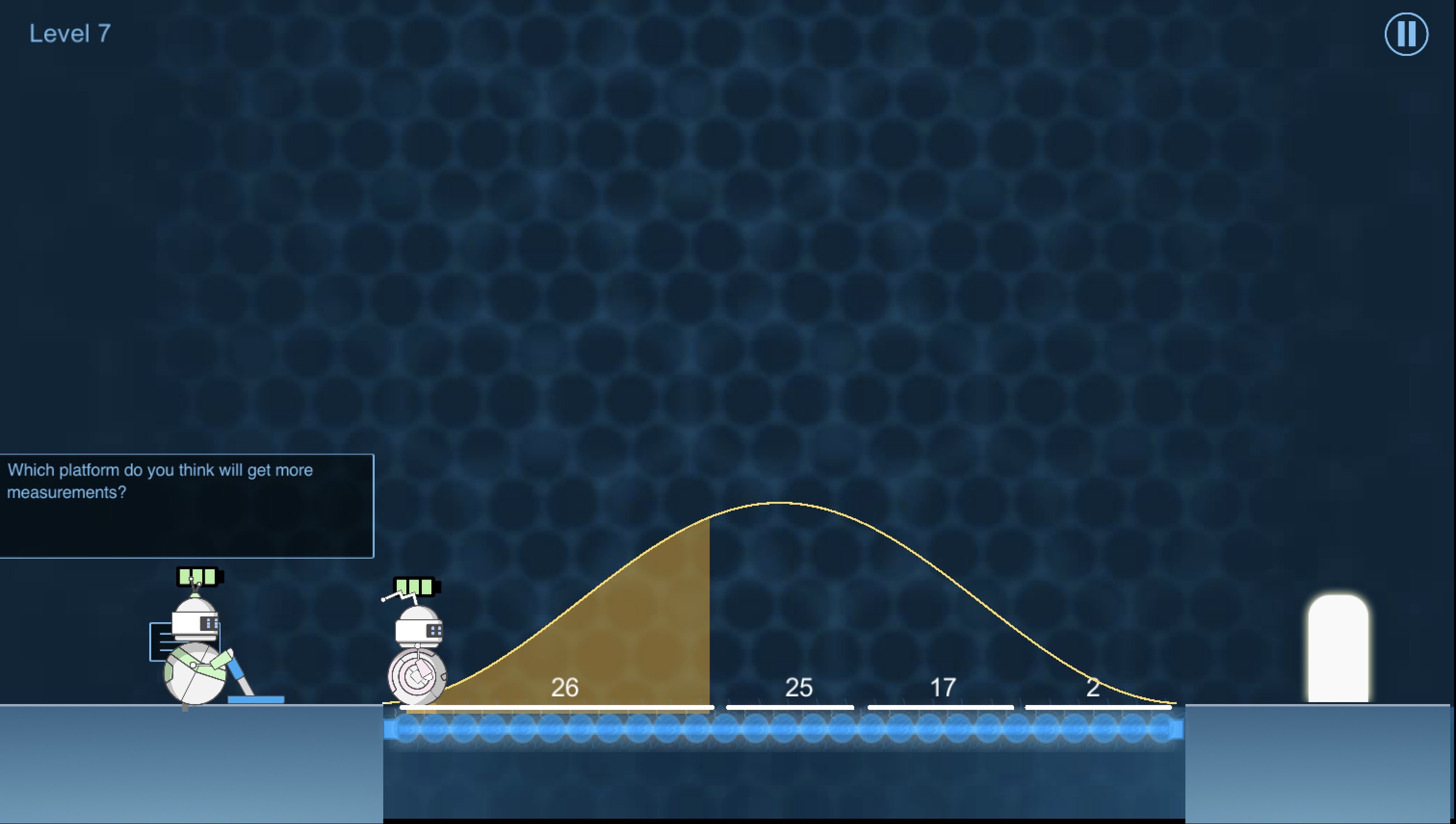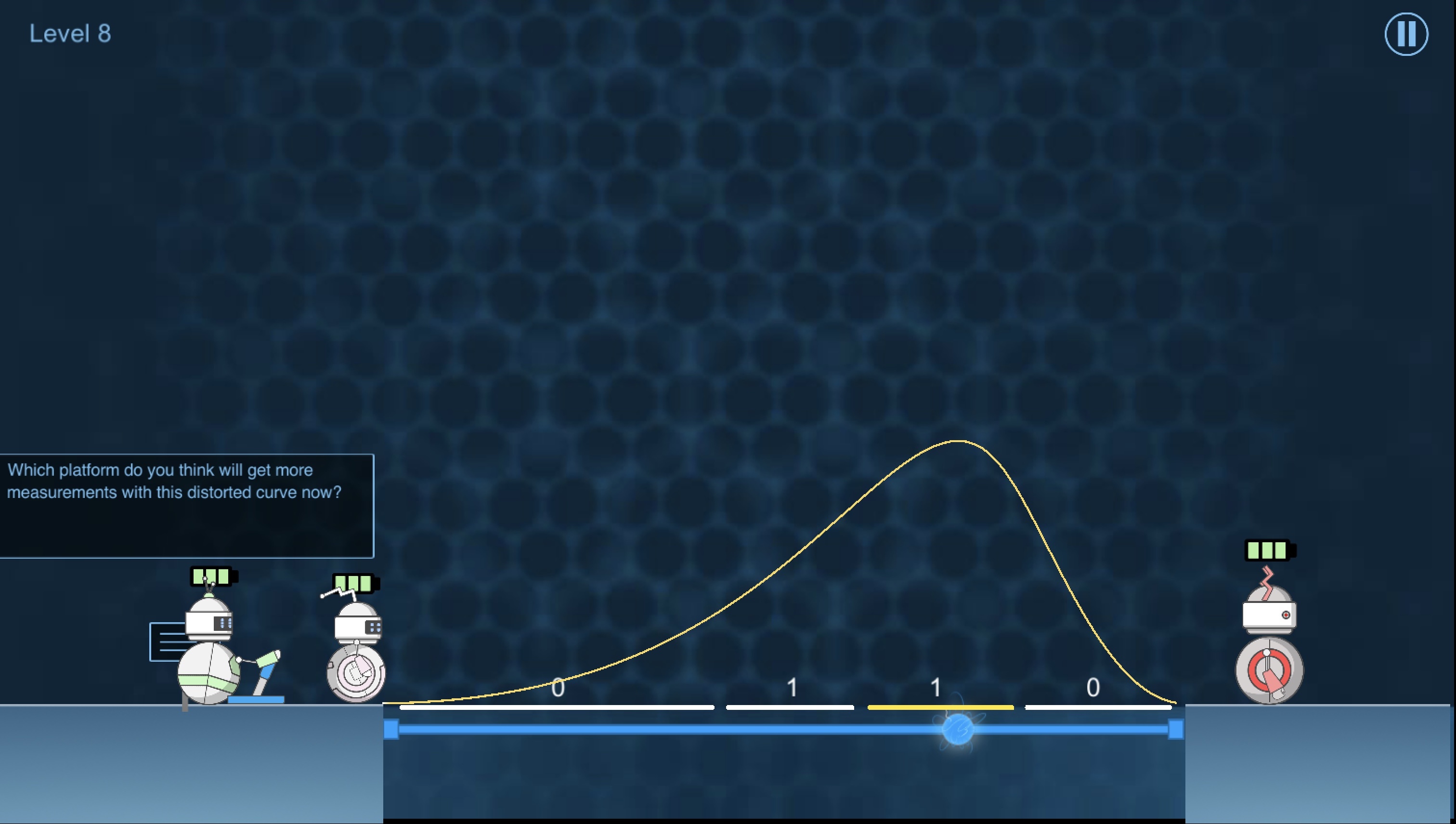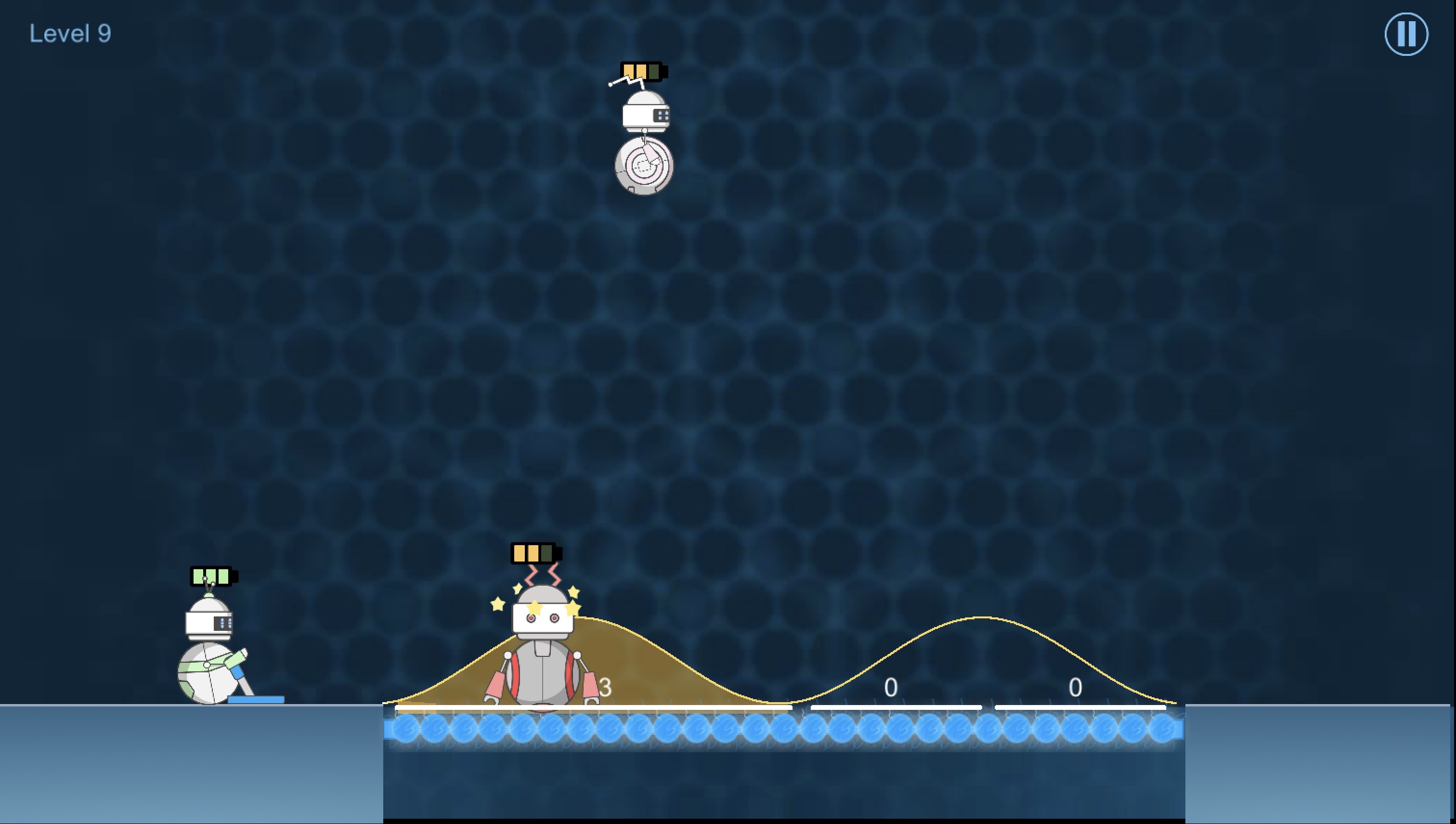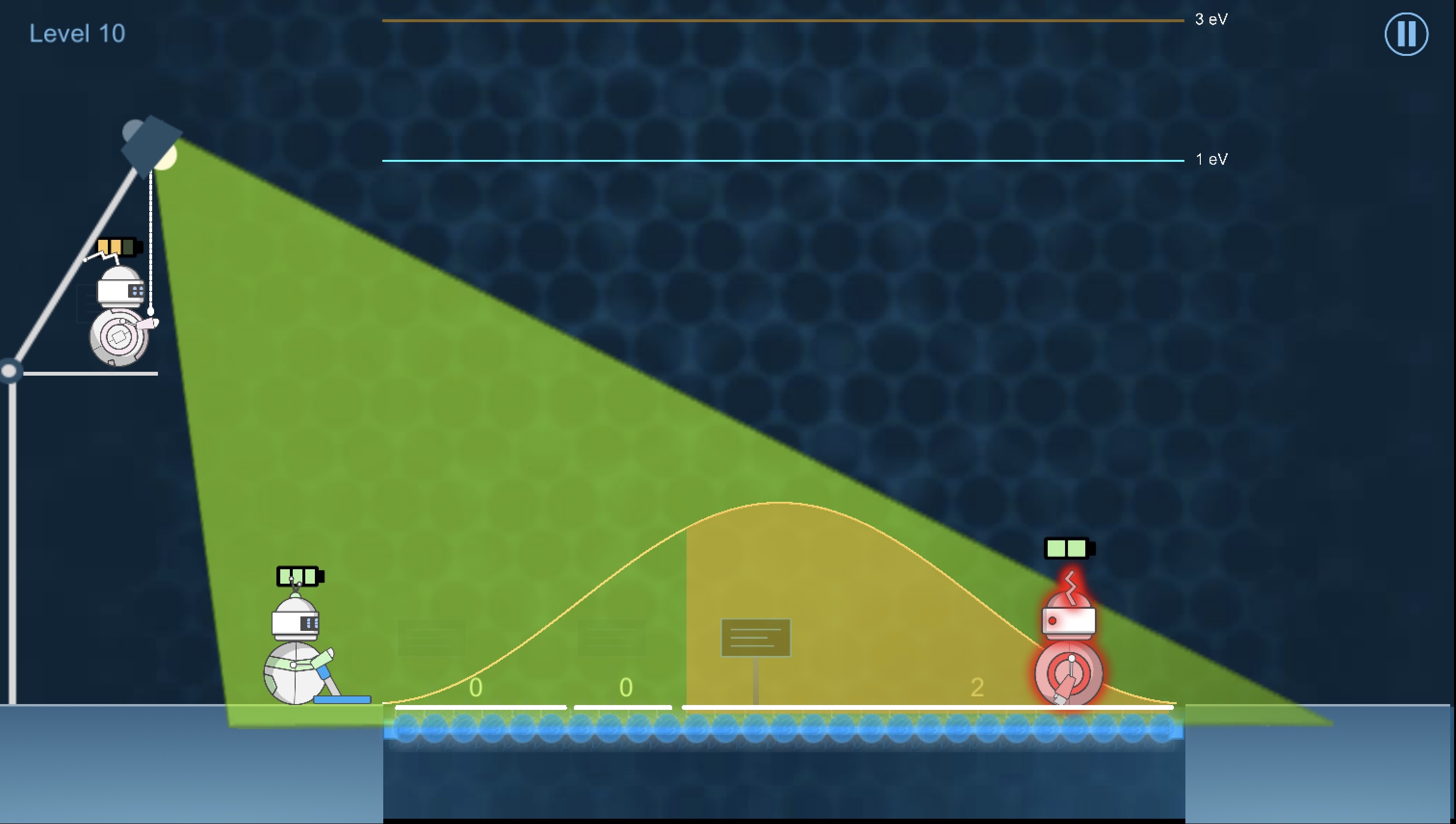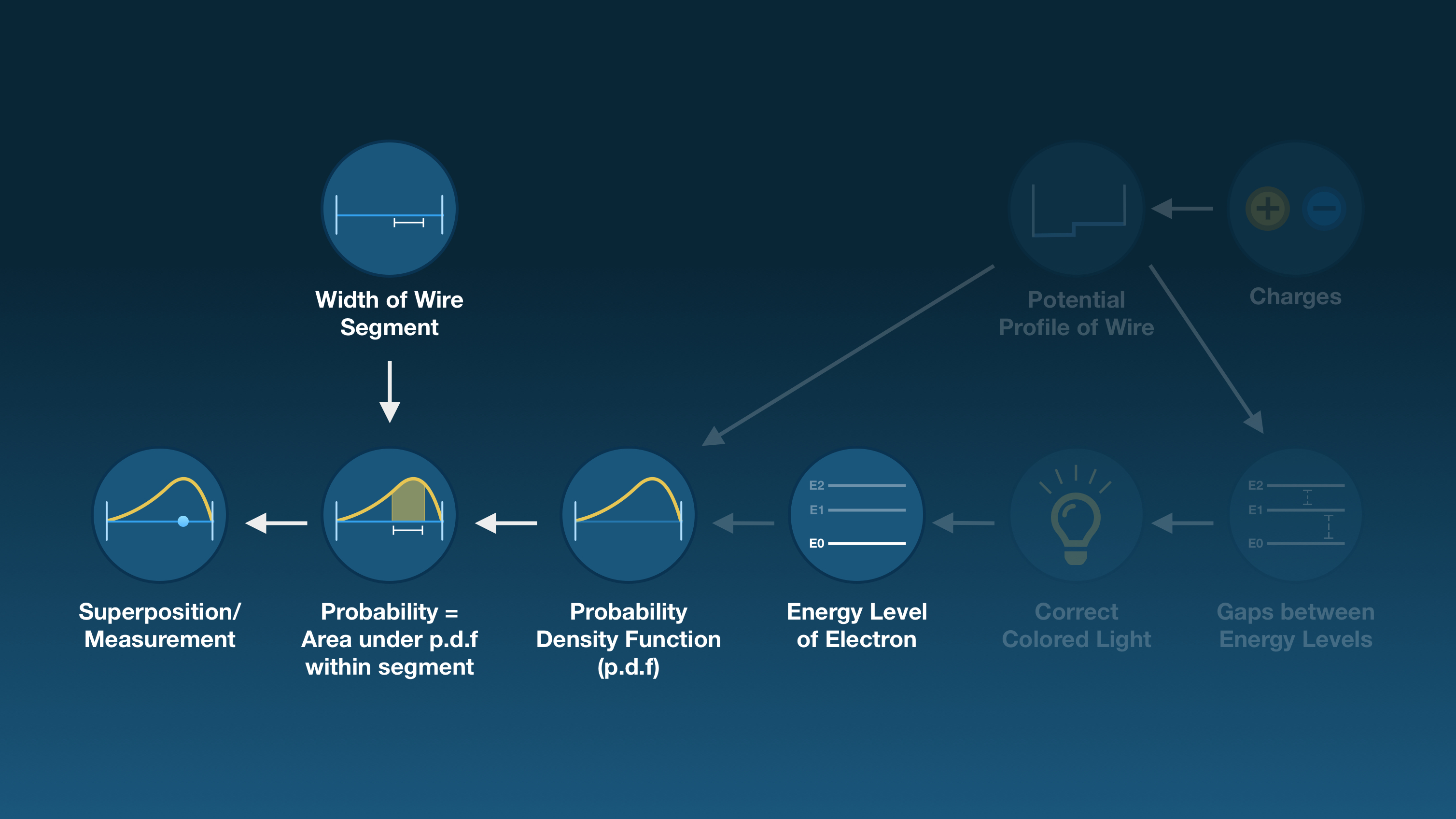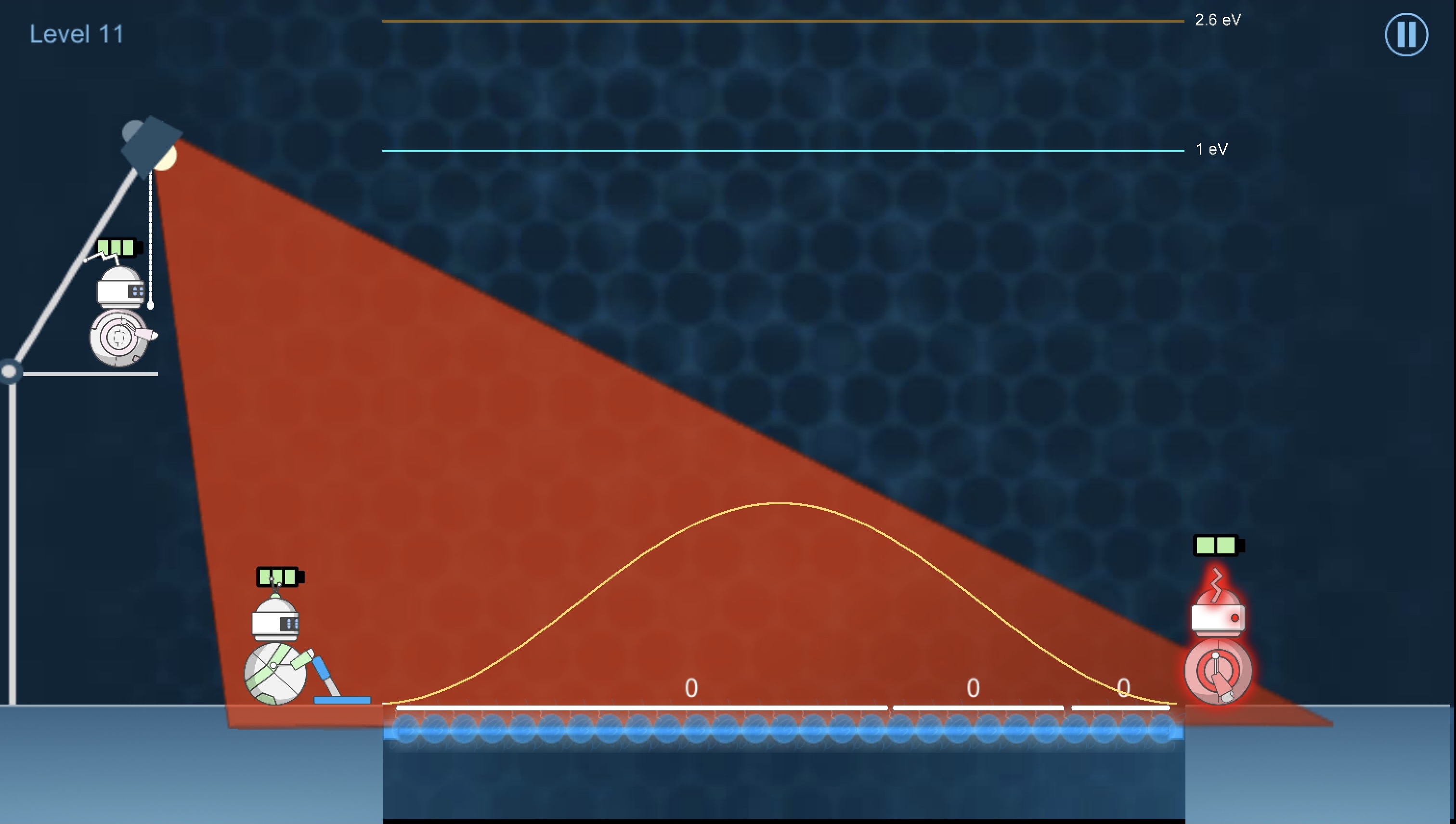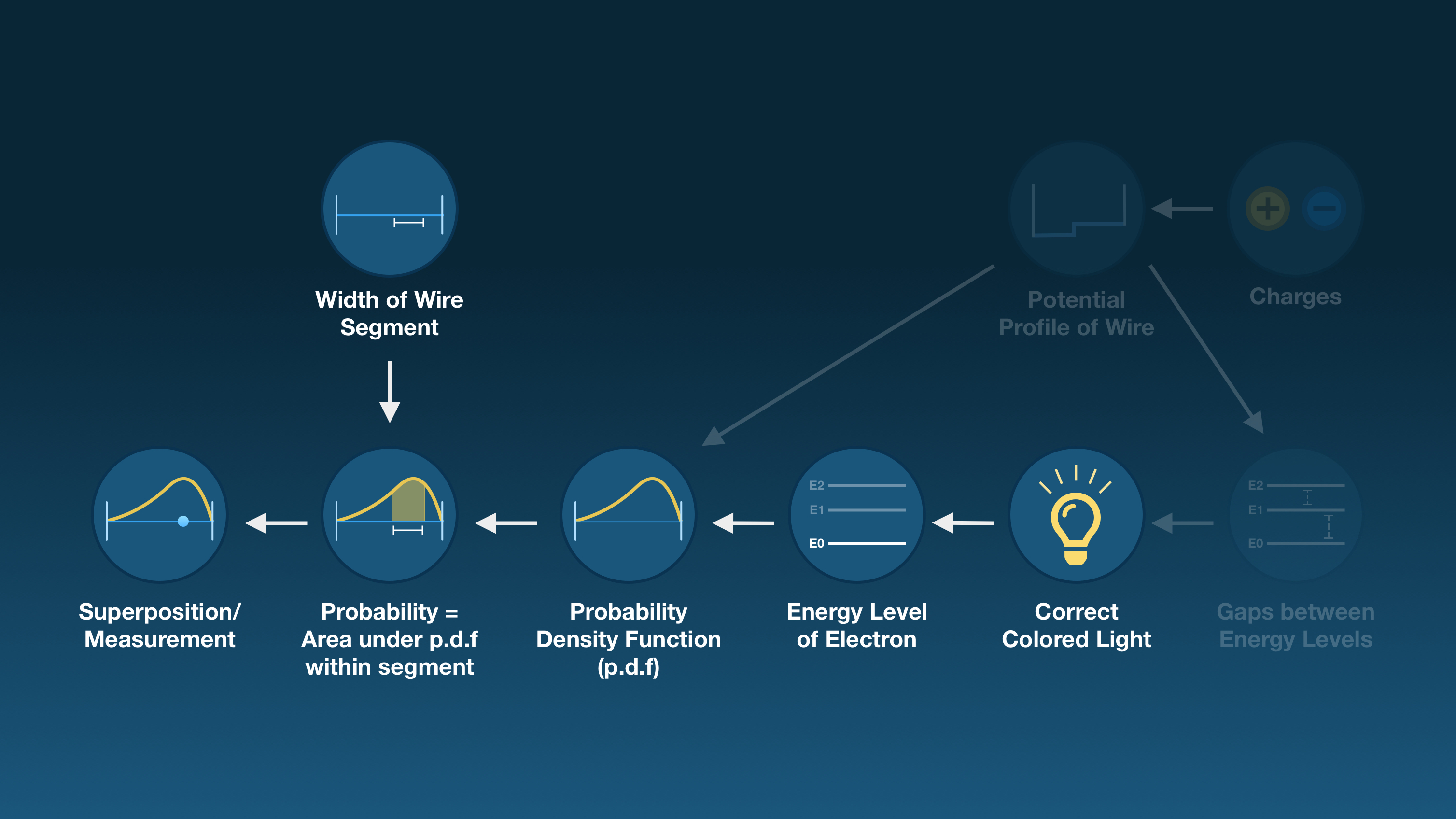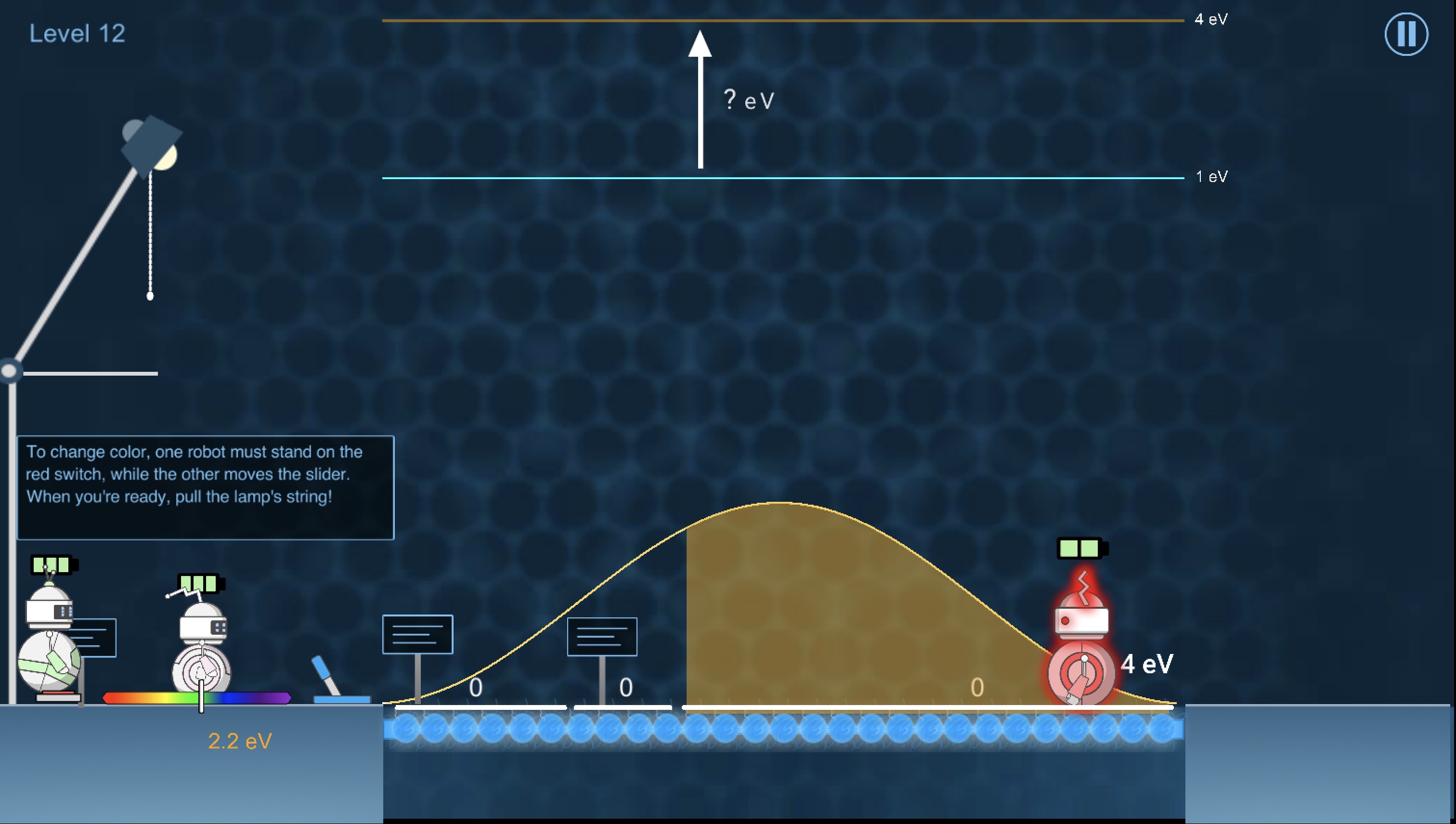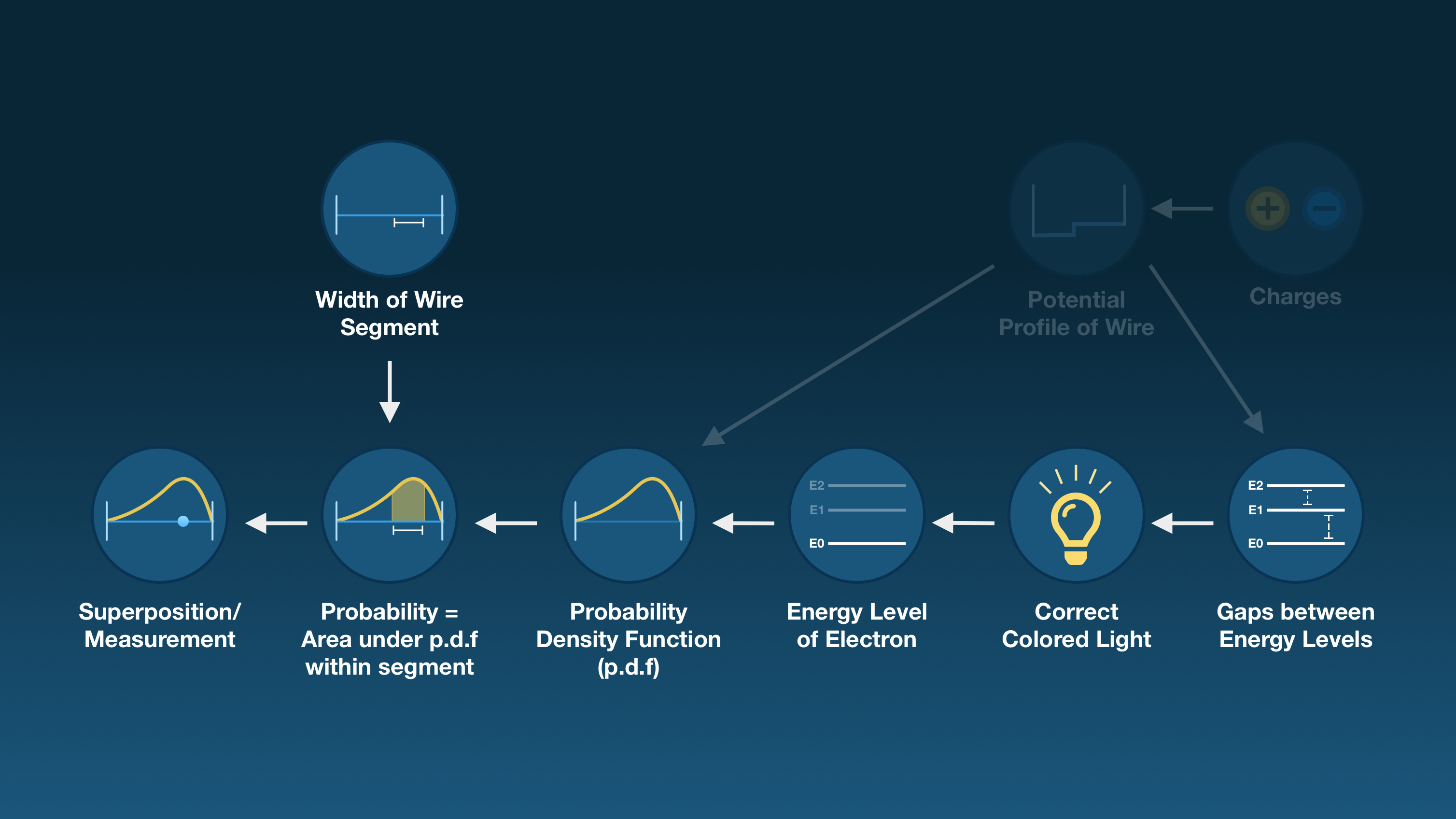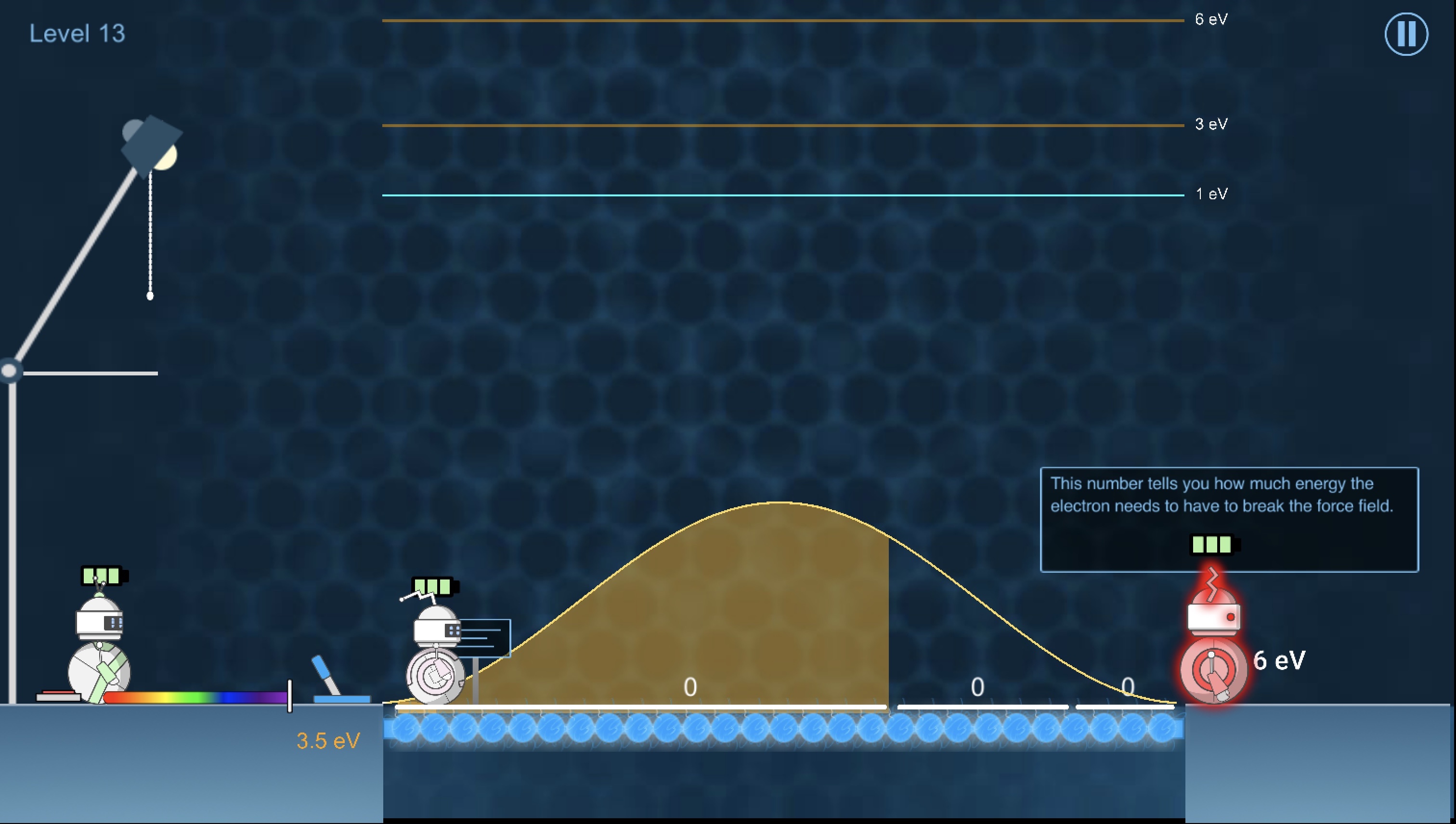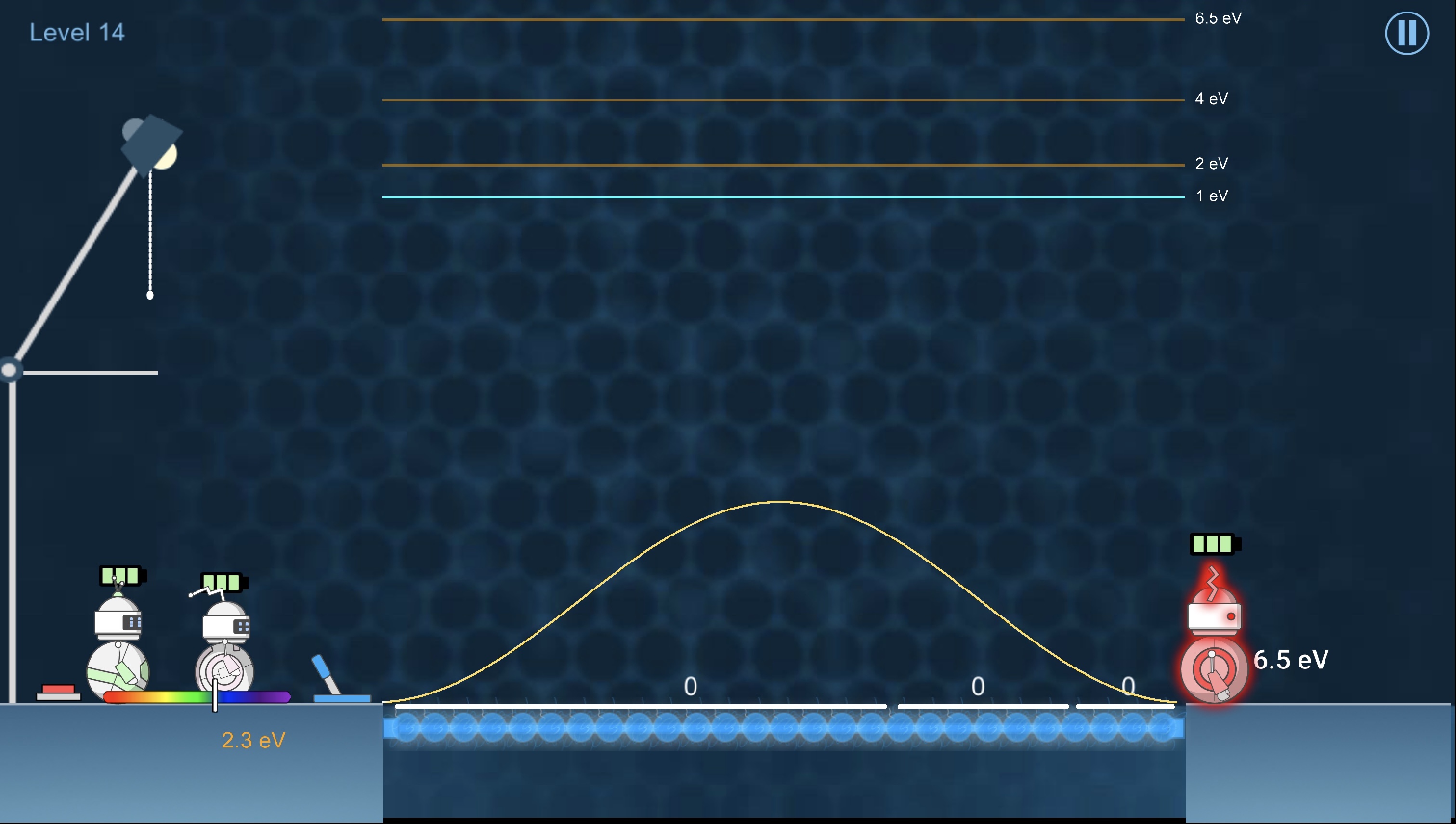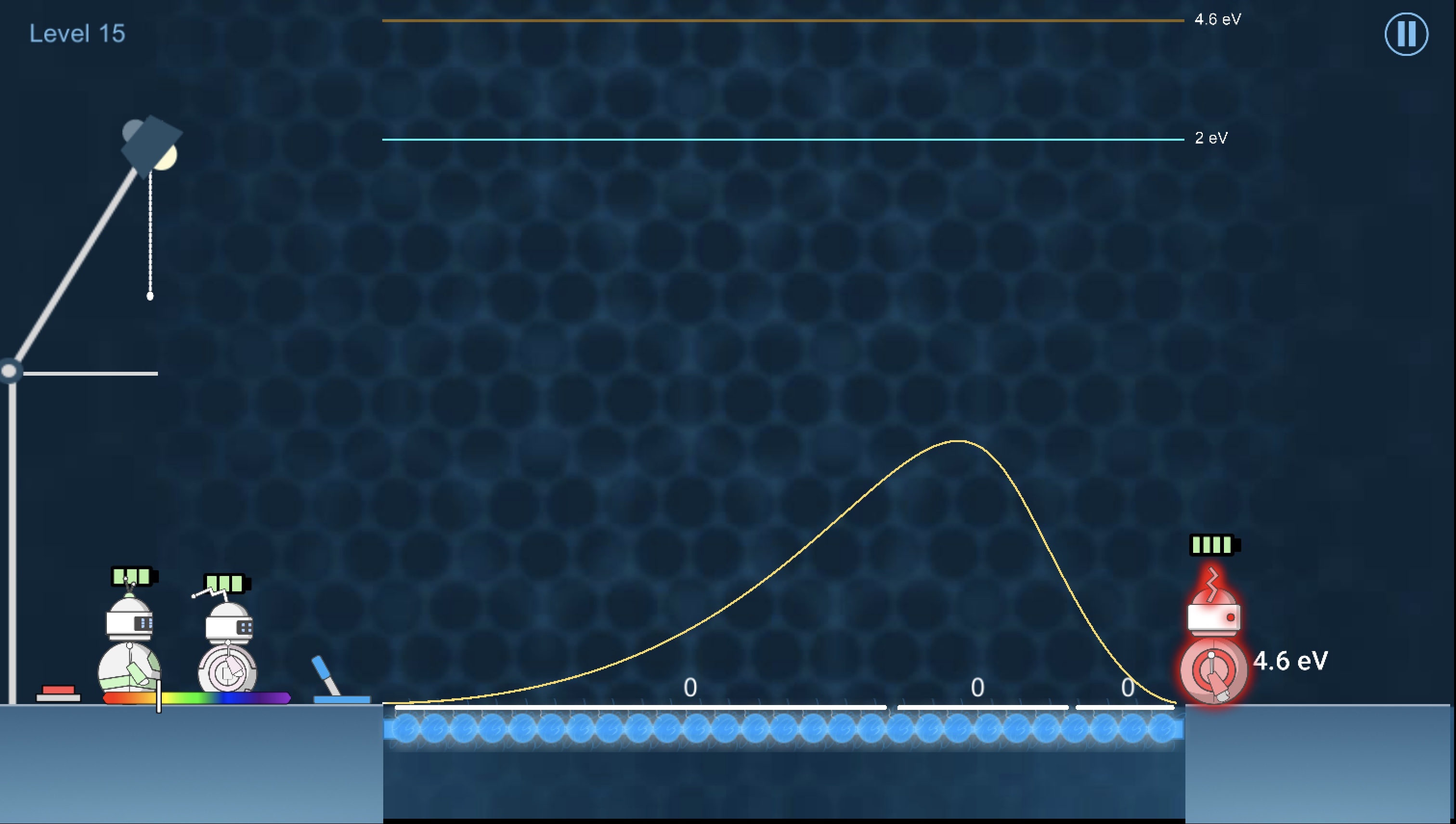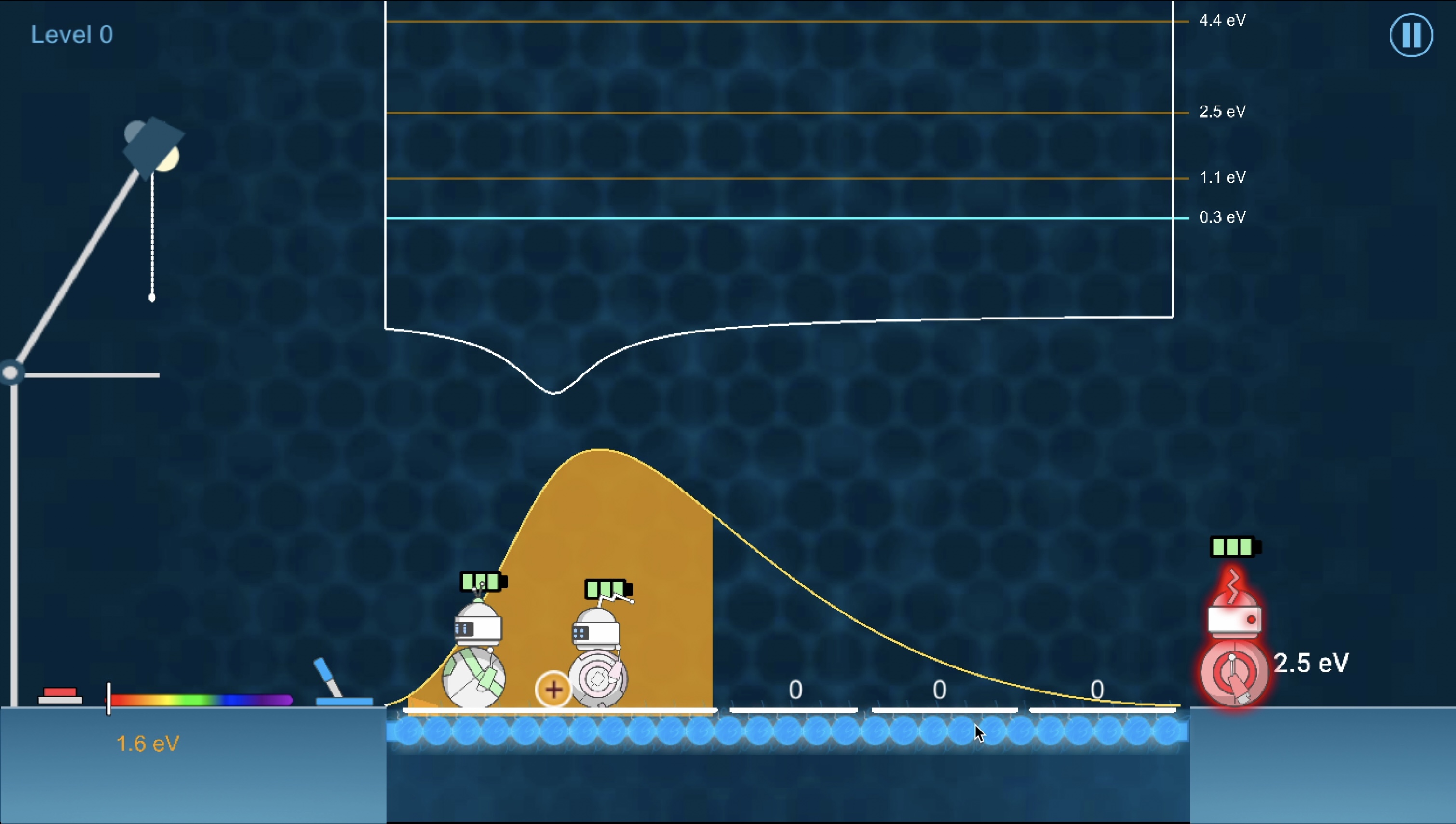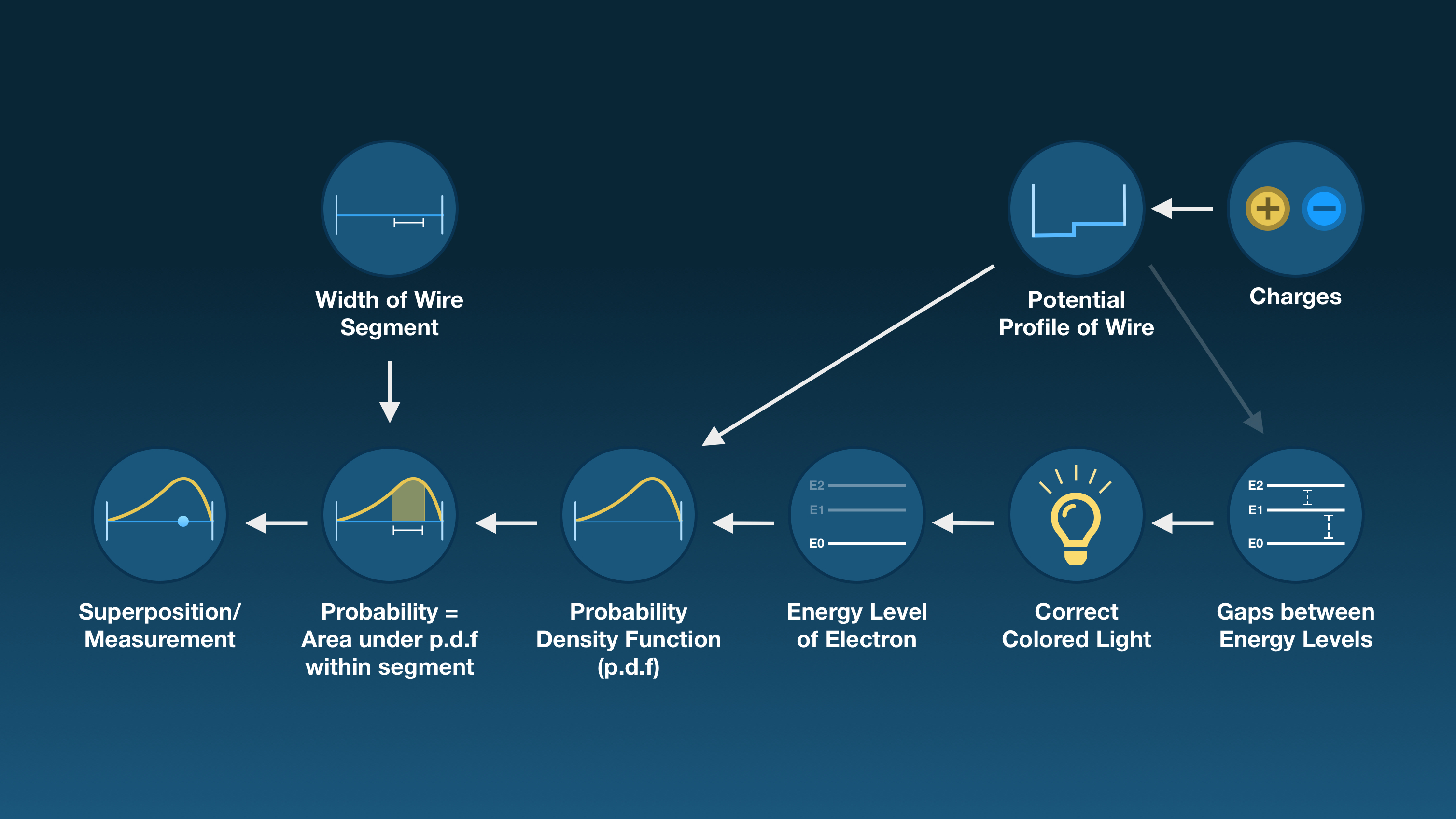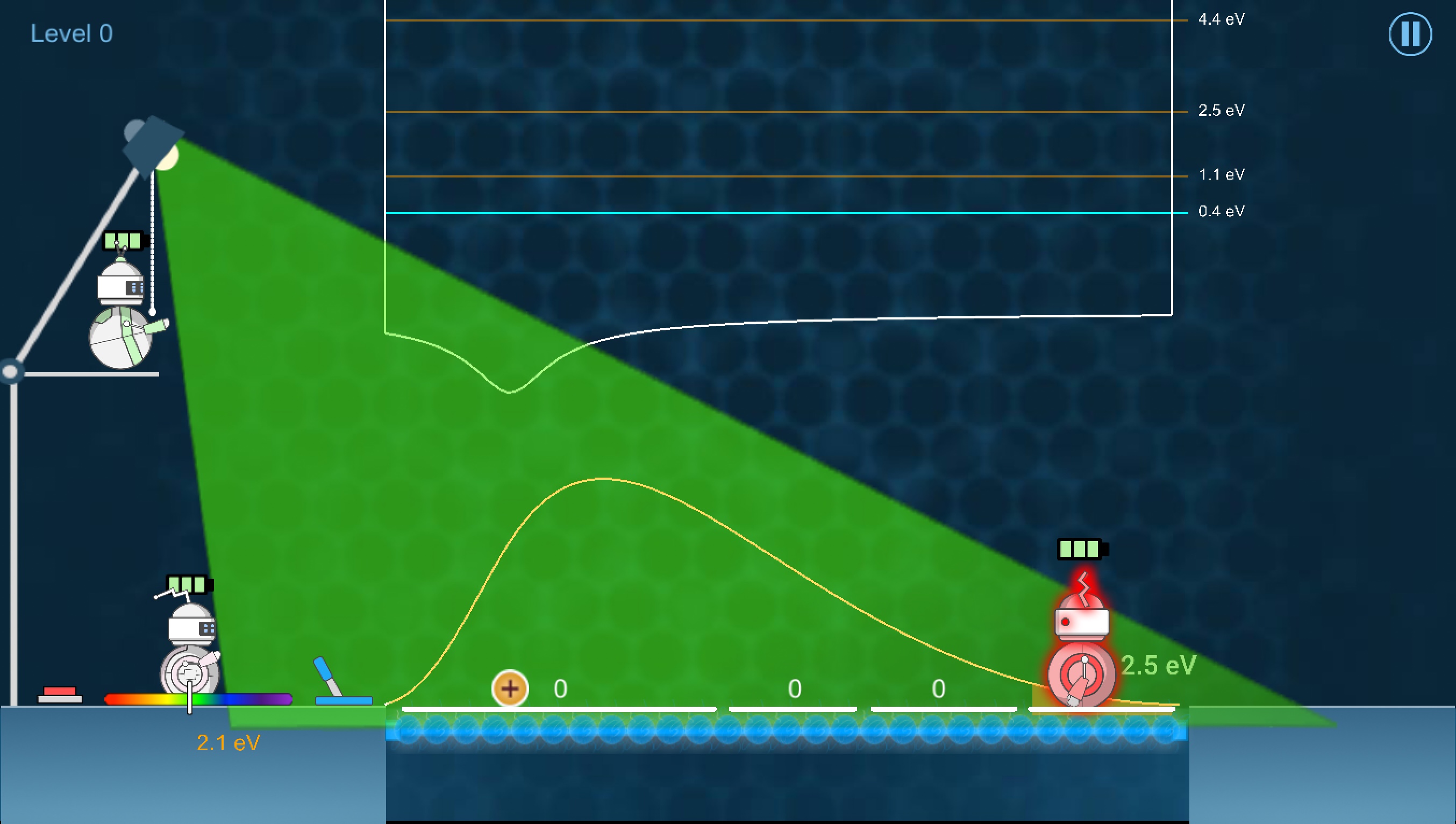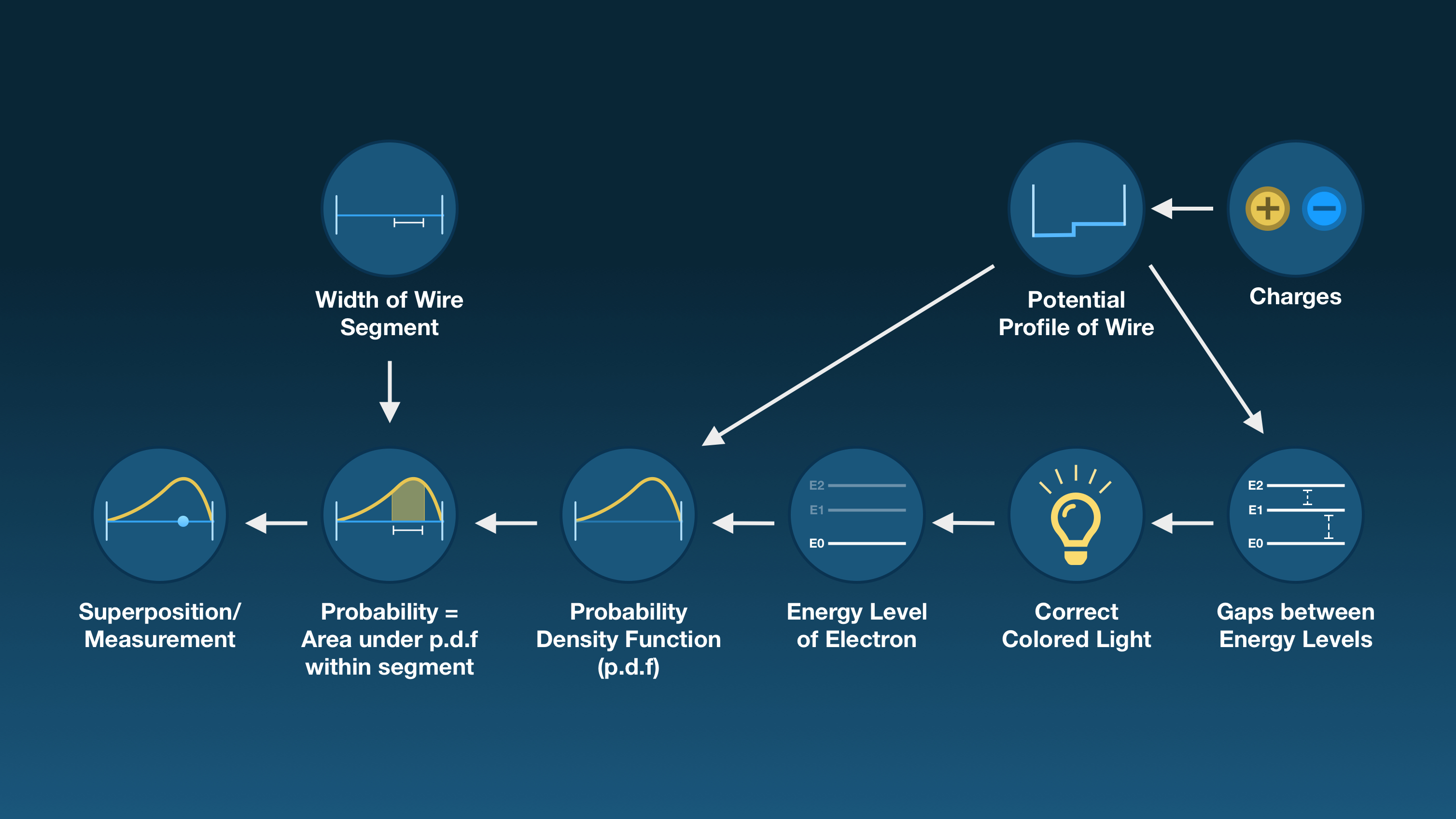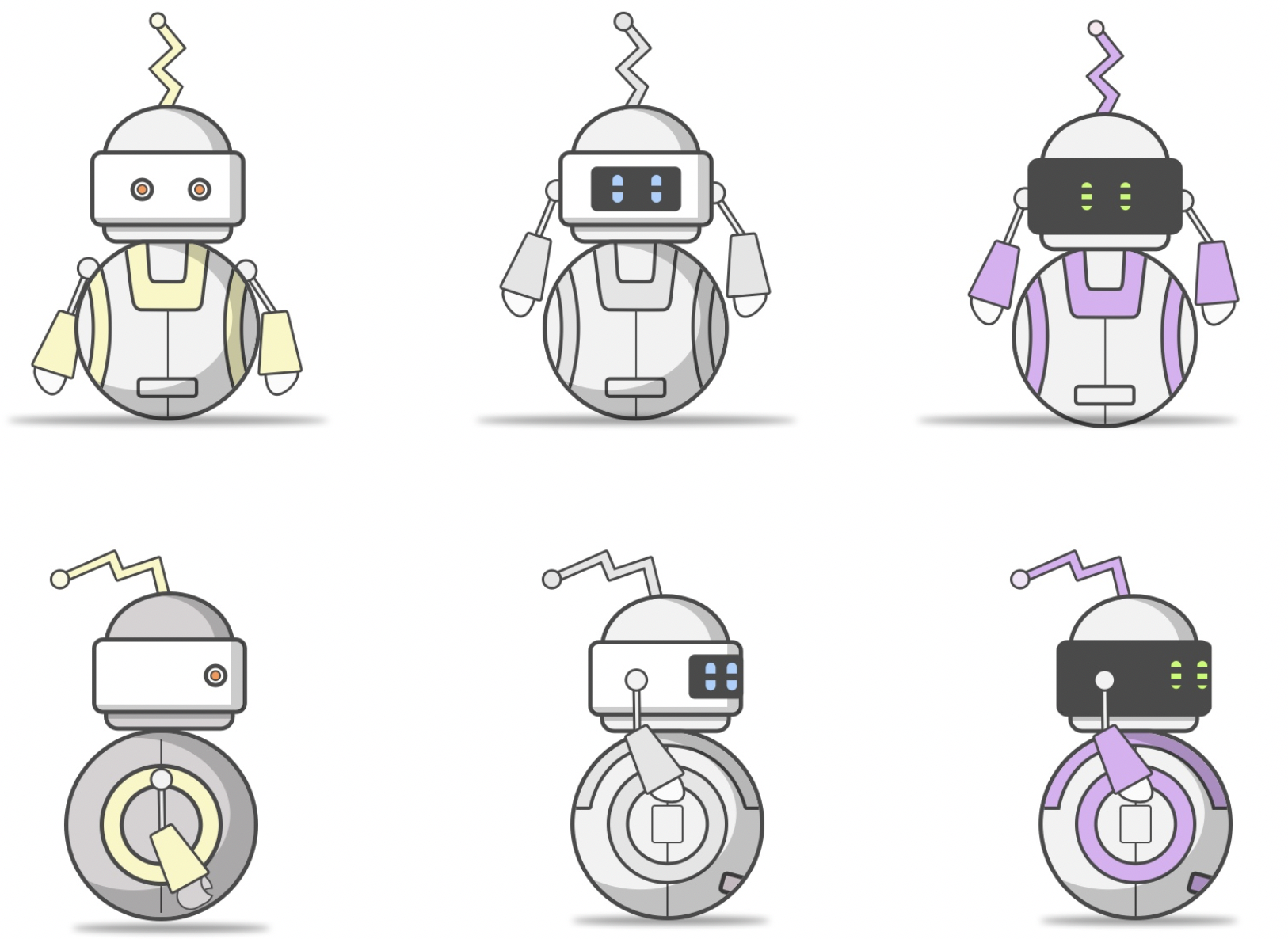Psi and Delta (formerly Particle in a Box)
A game for teaching introductory quantum physics
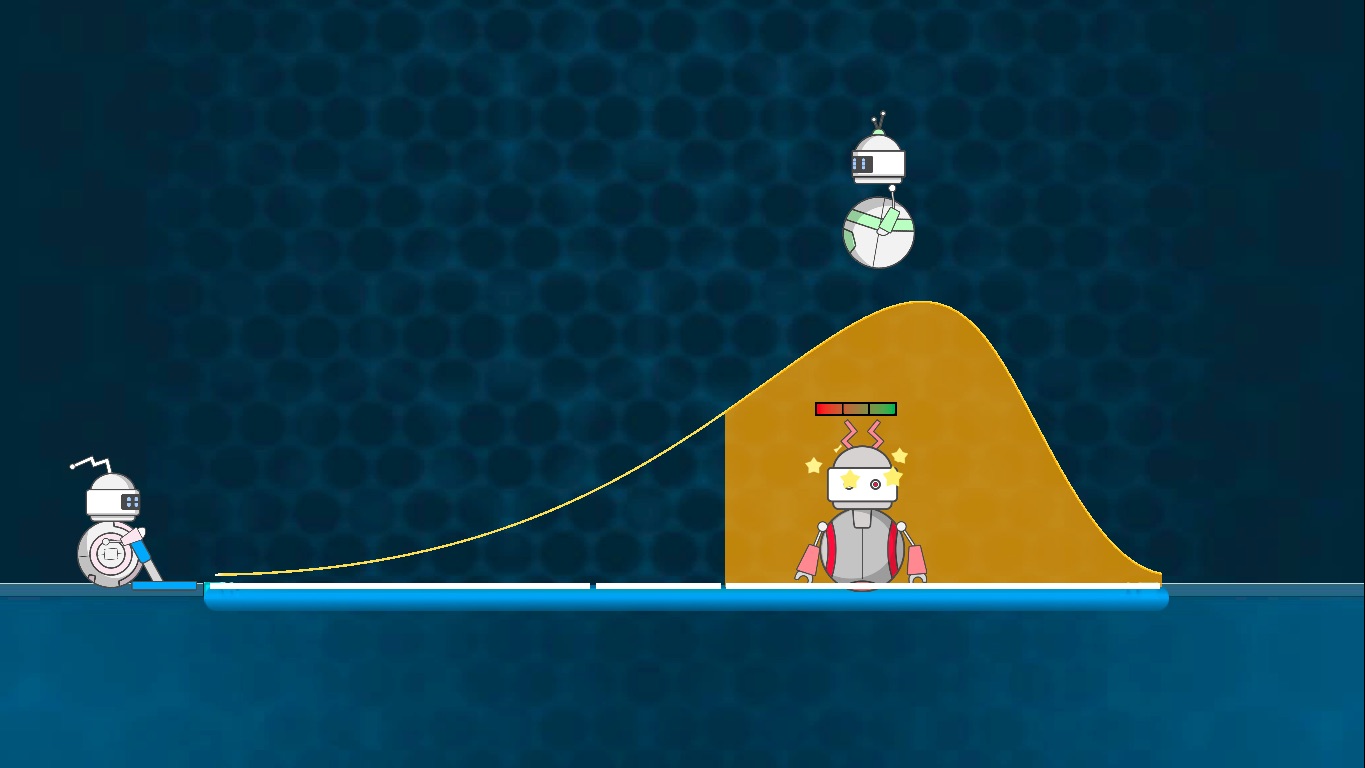
Trailer
Awards and Recognition
Overview
Engine: Unity
Genre(s): Platformer, Educational
Project Duration: Aug 2015 – May 2018
“Psi and Delta” is a digital local multiplayer game (also available in Single Player) designed to support high school and undergraduate students in learning introductory quantum physics.
Made in collaboration with electrical engineers, media scholars, and HCI students and faculty at Georgia Tech, the game is designed to help students explore and experiment with virtual worlds following the laws of quantum physics. It aims to promote learning by requiring players to cooperate, understand, and employ concepts of quantum mechanics together to resolve in-game challenges.
Select Publications
- Seskir, Zeki C., Piotr Migdał, Carrie Weidner, Aditya Anupam, Nicky Case, Noah Davis, Chiara Decaroli, et al. 2022. “Quantum Games and Interactive Tools for Quantum Technologies Outreach and Education.” Optical Engineering 61 (08). https://doi.org//10.1117/1.OE.61.8.081809
- Anupam, Aditya, Ridhima Gupta, Shubhangi Gupta, Zhendong Li, Nora Hong, Azad Naeemi, and Nassim JafariNaimi. 2020. “Design Challenges for Science Games: The Case of a Quantum Mechanics Game.” International Journal of Designs for Learning 11 (1): 1–20. https://doi.org/10.14434/ijdl.v11i1.24264
- Anupam, Aditya, Shubhangi Gupta, Azad Naeemi, and Nassim Parvin. 2019. “Beyond Motivation and Memorization: Fostering Scientific Inquiry with Games.” In Proceedings of the 2019 Annual Symposium on Computer-Human Interaction in Play Companion Extended Abstracts, 9. Barcelona, Spain. https://dl.acm.org/doi/abs/10.1145/3341215.3356309
- Anupam, Aditya, Ridhima Gupta, Azad Naeemi, and Nassim JafariNaimi. 2018. “Particle in a Box: An Experiential Environment for Learning Introductory Quantum Mechanics.” IEEE Transactions on Education 61 (1): 29–37. https://doi.org/10.1109/TE.2017.2727442.
The System
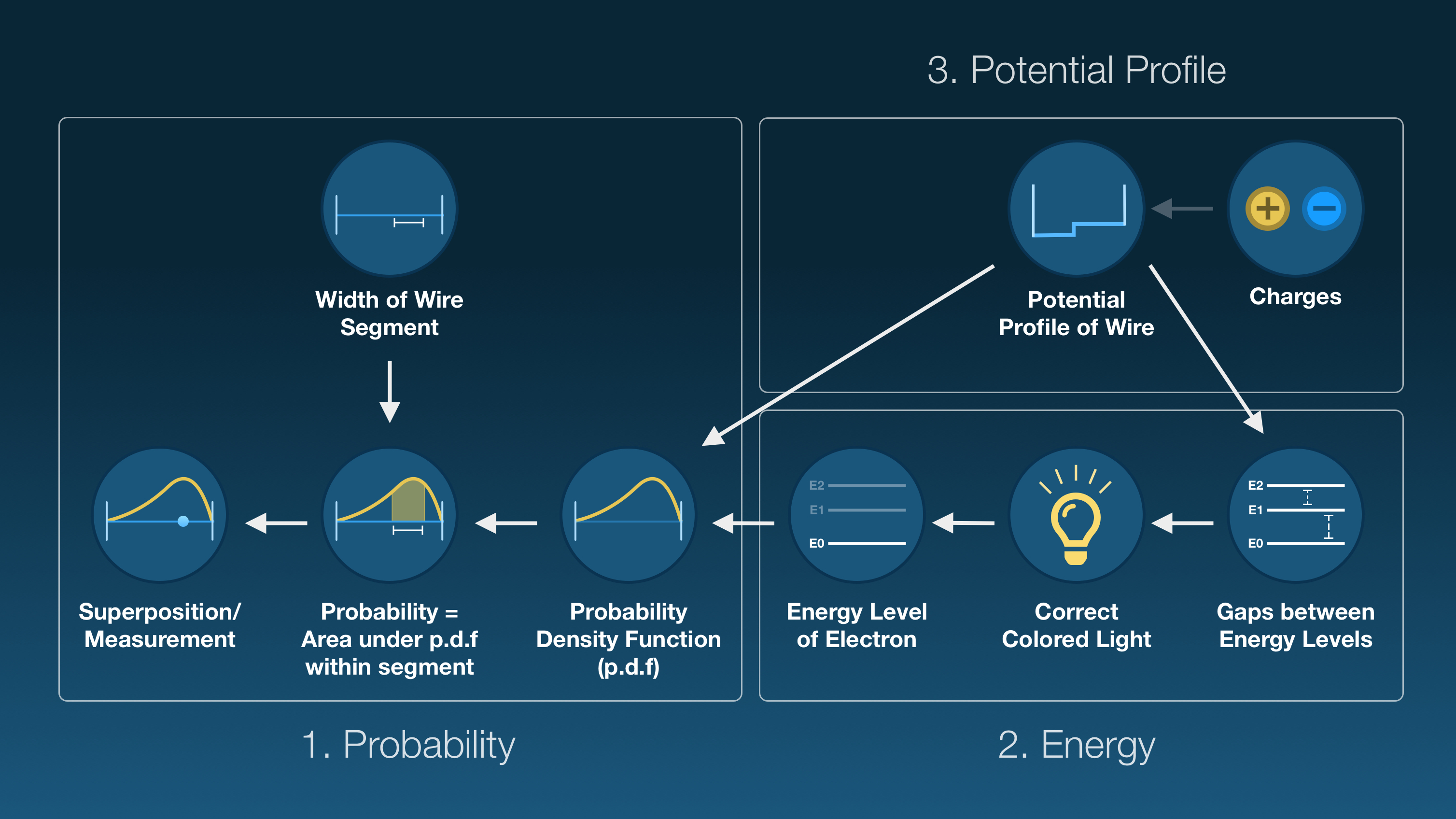
Concept Map illustrating the key relationships of the quantum system
Quantum Mechanics (QM) is the foundation for science and engineering disciplines as diverse as semiconductor physics, chemistry, and material science. However, educators face major challenges in teaching QM given the abstract, non-experiential and counter-intuitive nature of its concepts. Further, introductory quantum mechanics courses and texts predominantly focus on the mathematical formulations of the subject and lay less emphasis on its conceptual understanding. Consequently, students struggle to develop robust conceptual mental models of QM concepts. Digital games can facilitate a conceptual understanding of QM by immersing players in virtual worlds governed by the rules of QM, allowing them to explore and experiment with its concepts in a way that would not be possible in the class.
Specifically, the goal of the game is to teach the following core concepts of QM:
- Infer, from the probability distribution function (p.d.f), the relative probability of measuring an electron in different areas.
- Infer, from the energy level diagrams, the energy (and color of light) needed for transition and its effect on the p.d.f.
- Describe how charge distribution affects the potential profile and in turn, the energy levels and p.d.f
Level Design/Progression (Carousel)
Game Mechanics
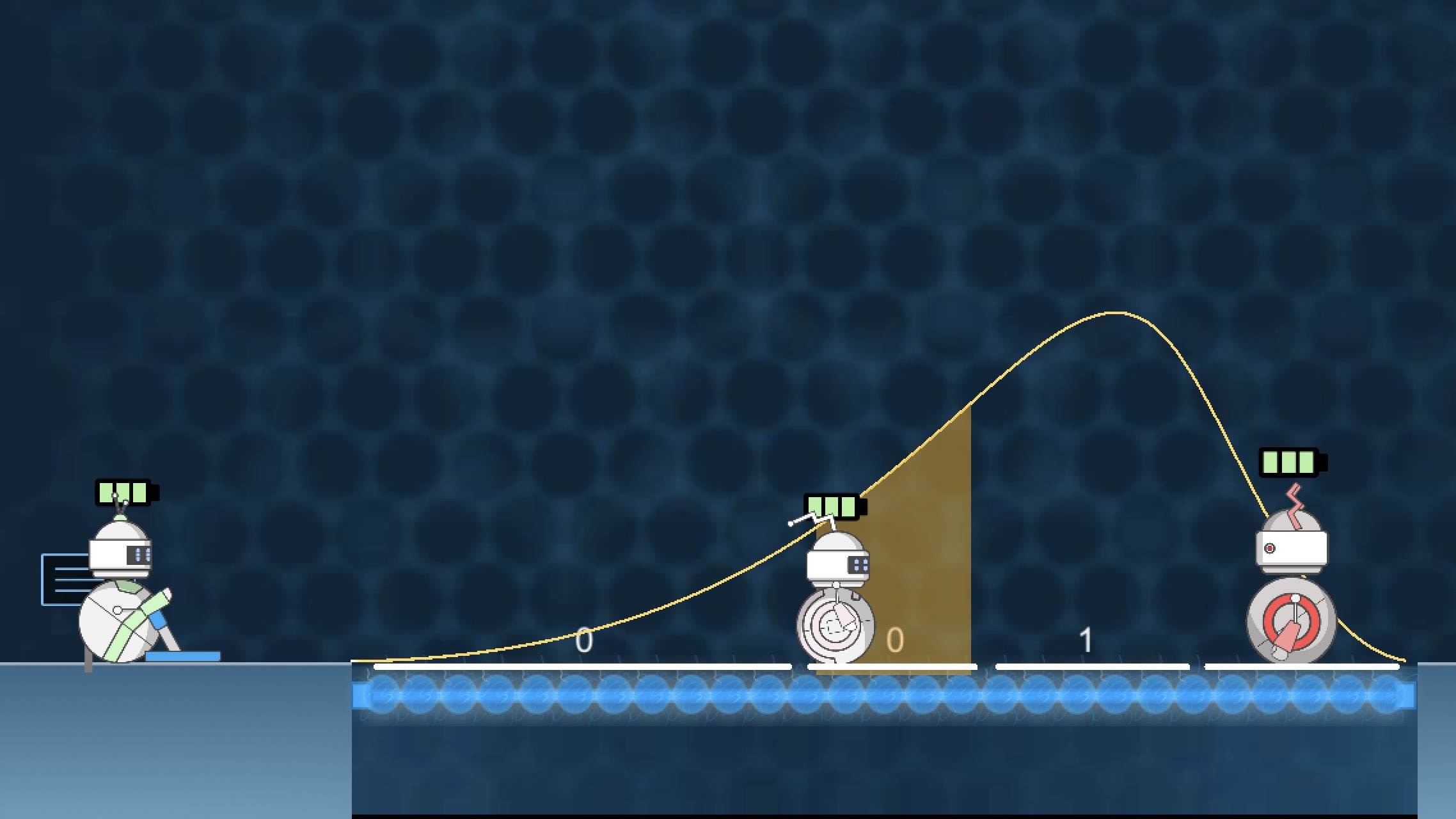
Luring: One player (say Player 1) goes close to the enemy bot in order to lure it. The electron is currently in its wave state under the player on a wire.
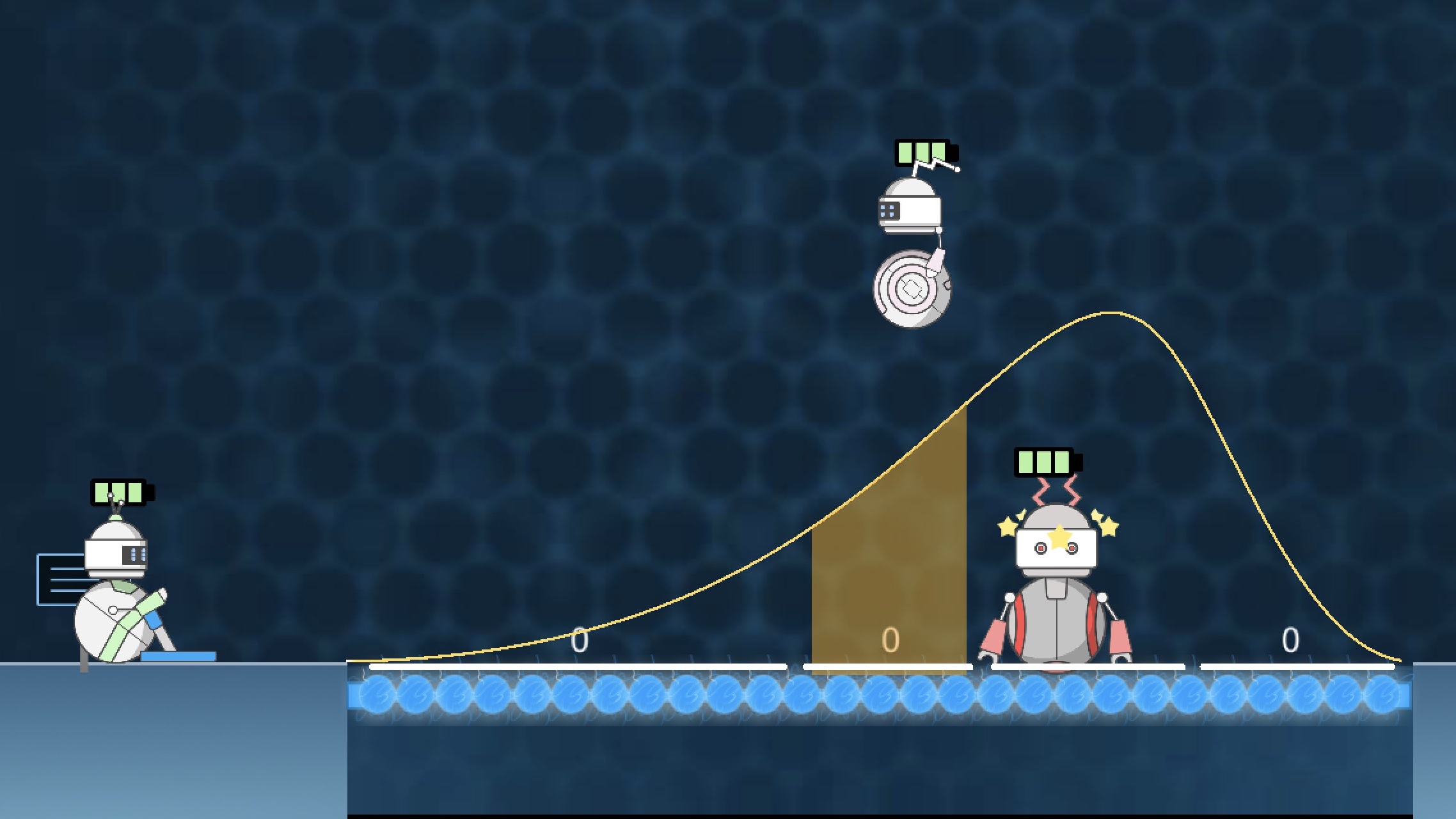
Stunning: Once the enemy bot is lured onto the wire, the goal for Player 2 is to shock the enemy without shocking Player 1. To do this, Player 1 can jump on the enemy to first stun them.
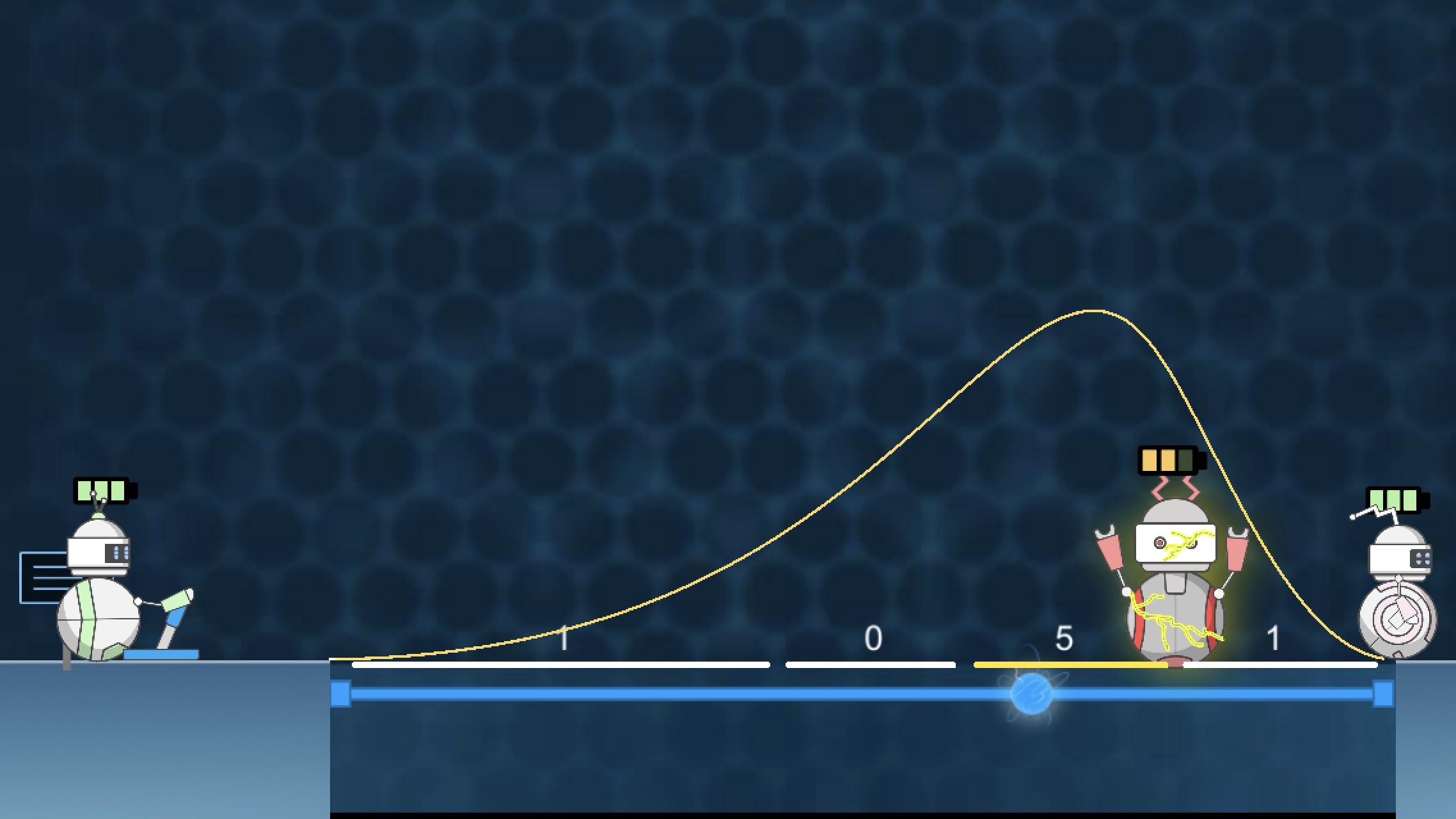
Shocking: Player 2 pulls a lever to trigger a measurement. This collapses the electron into its particle state. If the electron collapses under a platform on which the enemy (or player 1) is standing, it will shock the enemy robot/player.
(Video) Luring, Shocking, Stunning, Repeat!: After each measurement, the electron returns to its wave-state. Each time a player/enemy is shocked, they lose one life. The cycle of luring, stunning, shocking (measuring) repats until the enemy robot or a player has lost all their lives.
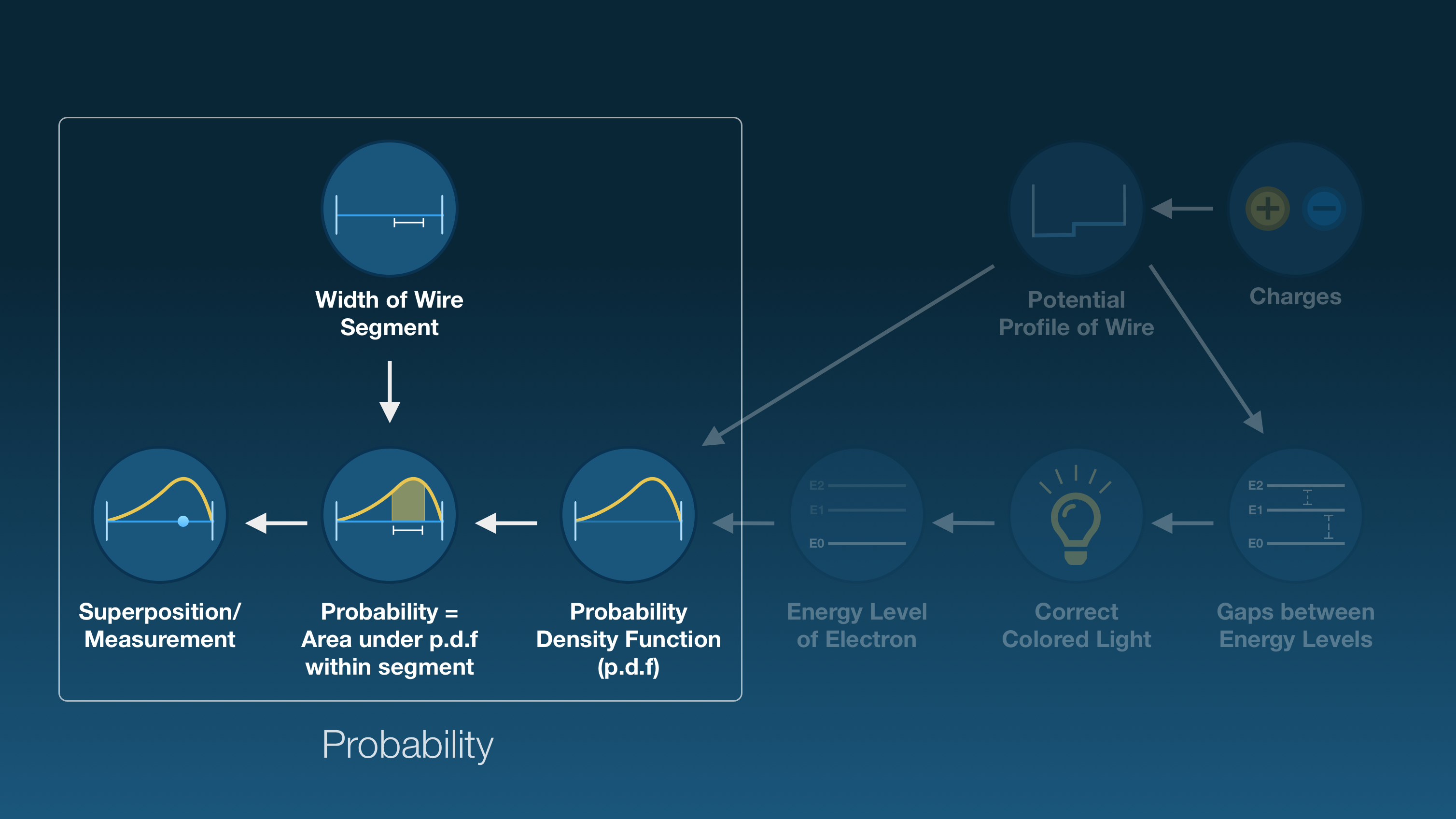
Relationship to Learning Objective 1: The electron is more likely to collapse in a region of high probability which is represented by the area under the curve (shaded orange region). The longer the platform and the higher the probability distribution function above it, the greater the area under the curve and the probability. To maximize their chances of shocking the enemy robot, players must understand the concepts of probability, measurement, and the width+ shape (area) of the curve.
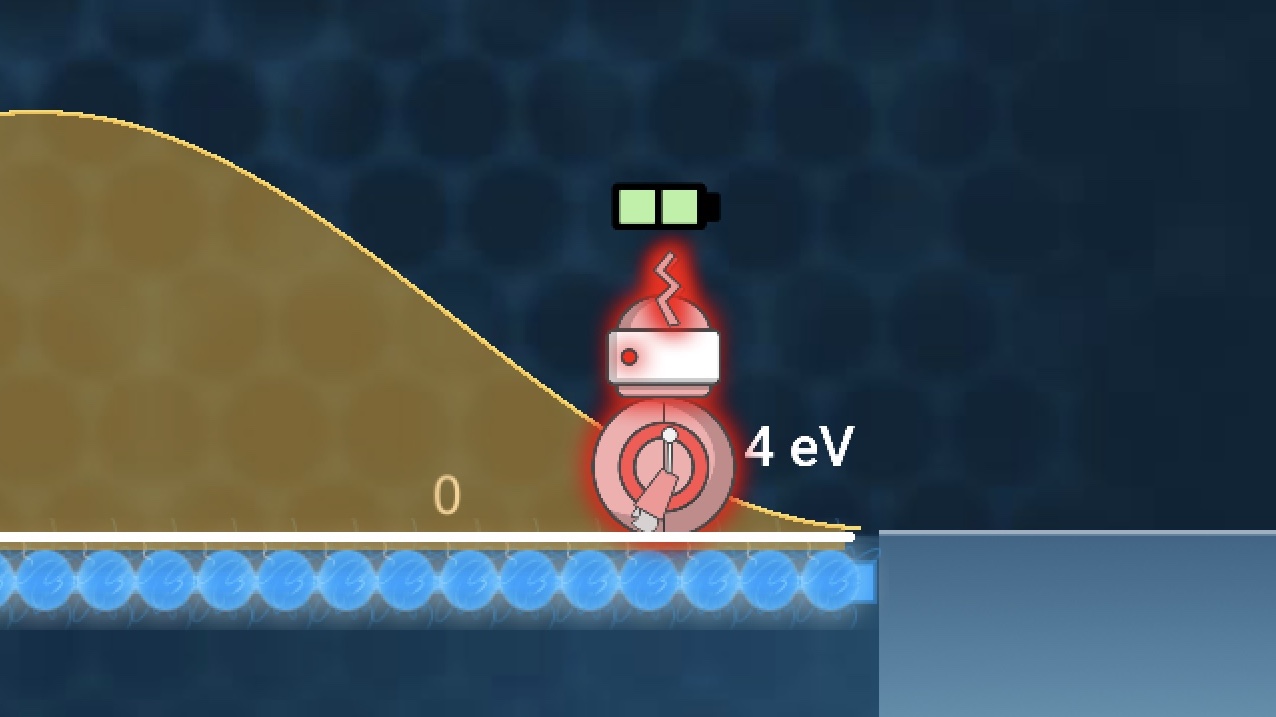
Shielded Enemy: The enemy robot now has a shield that protects it. To be able to shock it now, players have to increase the energy of the electron to be greater than the value listed next to the enemy’s shield (6 eV here). Otherwise, the electron will have no effect on the enemy bot.
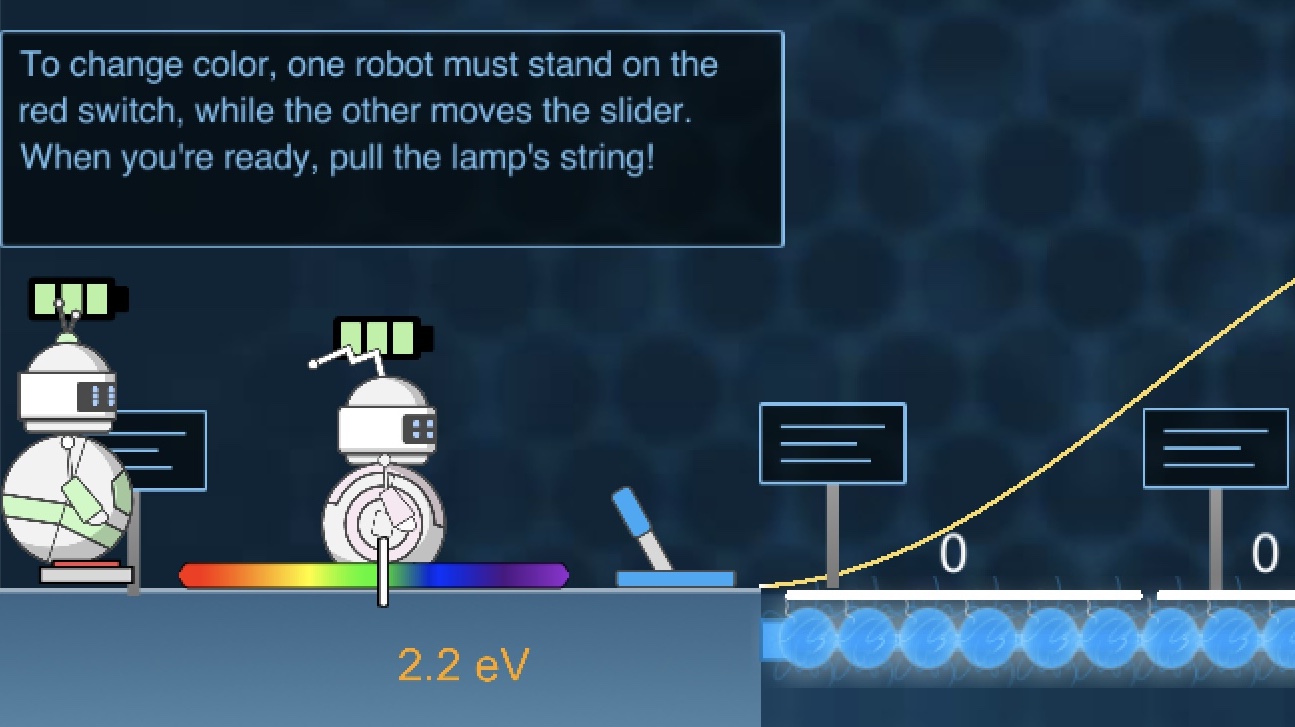
Color Calculation: To increase the electron's energy, players have to shine light on it with the correct color/energy from a lamp (top-left). To change the color of the lamp, one player (say Player 1) stands on the red button, which acivates the color spectrum. Player 2 can then move along the spectrum to change the color.
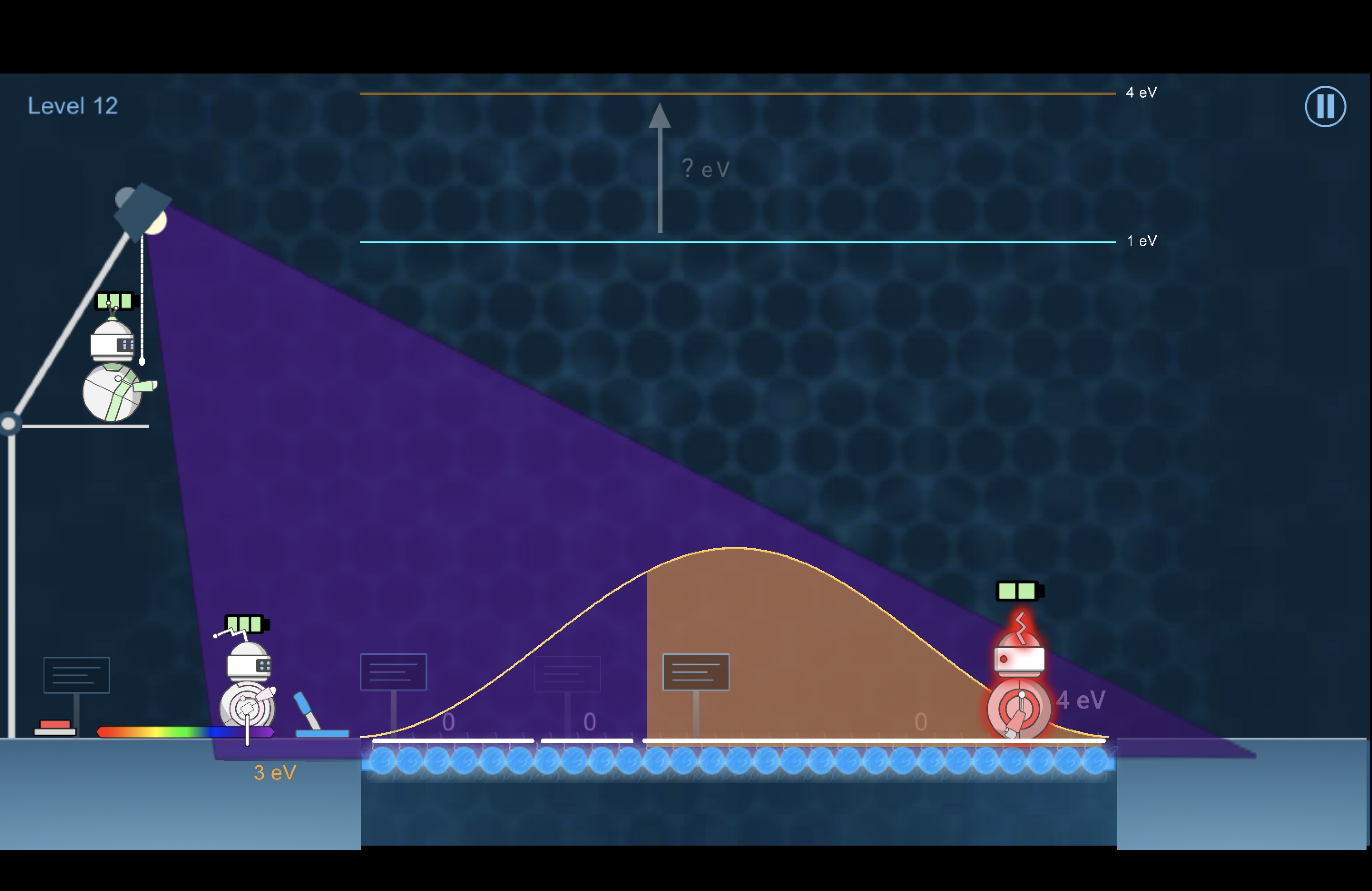
Shine!: Next, players must reach the ledge above and pull the switch. If the light shined is the correct color, the electron will absorb and increase its energy.
(Video) Observe, Calculate, Shine, Repeat!: Players need to keep increasing the electron’s energy until it is more than that of the enemy robot's shield. After that, players can return to luring and shocking the enemy robot.
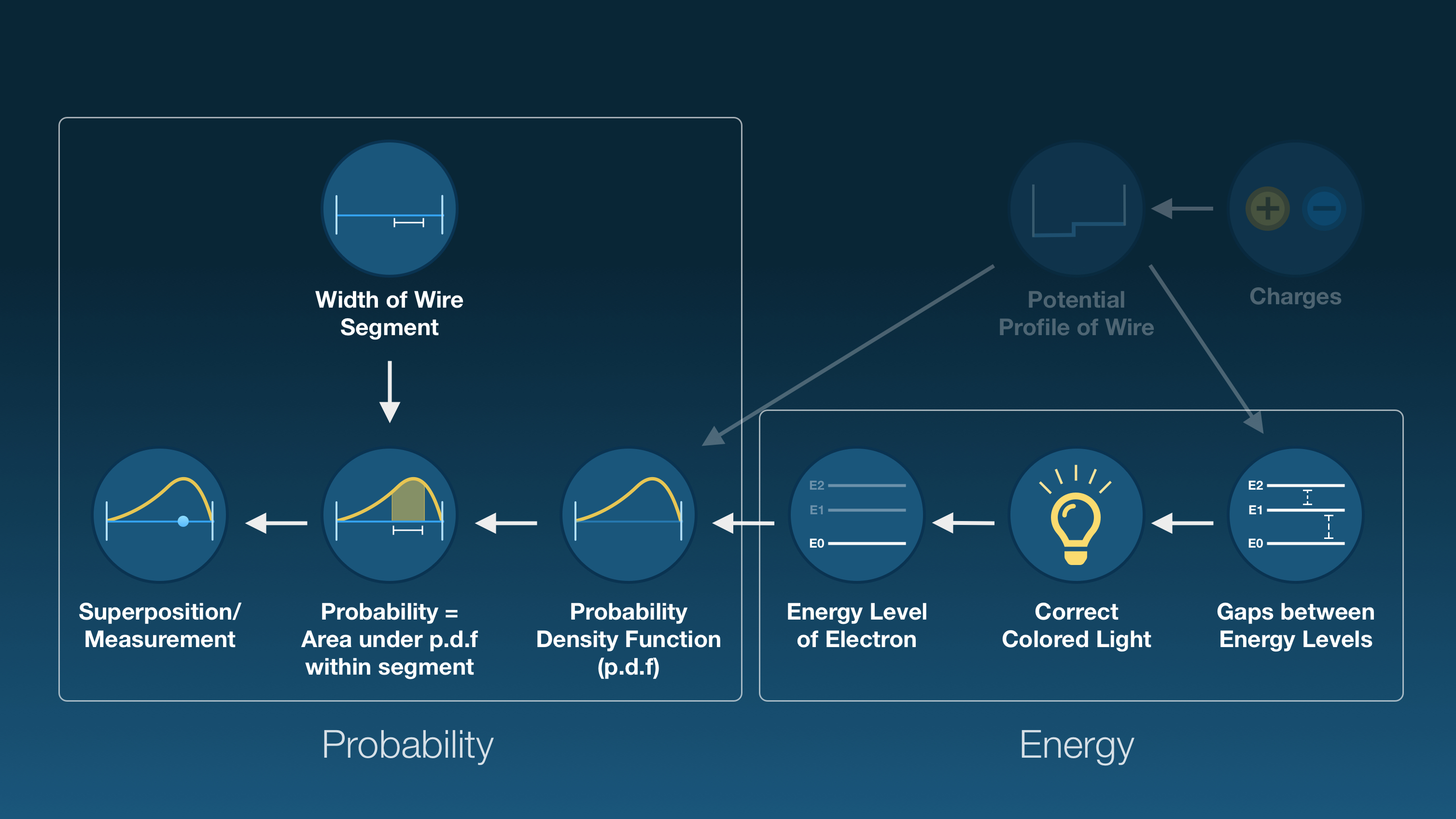
Relationship to Learning Objective 2: In order to increase the energy of the electron, players must learn to read the energy diagram and calculate how much energy is needed (and therefore what color of light must be shined) to excite the electron. If the light shined is the correct color, the electron will absorb it and its energy level will change. This will in turn change the shape of the probability distribution function (p.d.f). Once the appropraite energy is reached, players have to lure and shock the enemy robot in accordance with the new p.d.f.
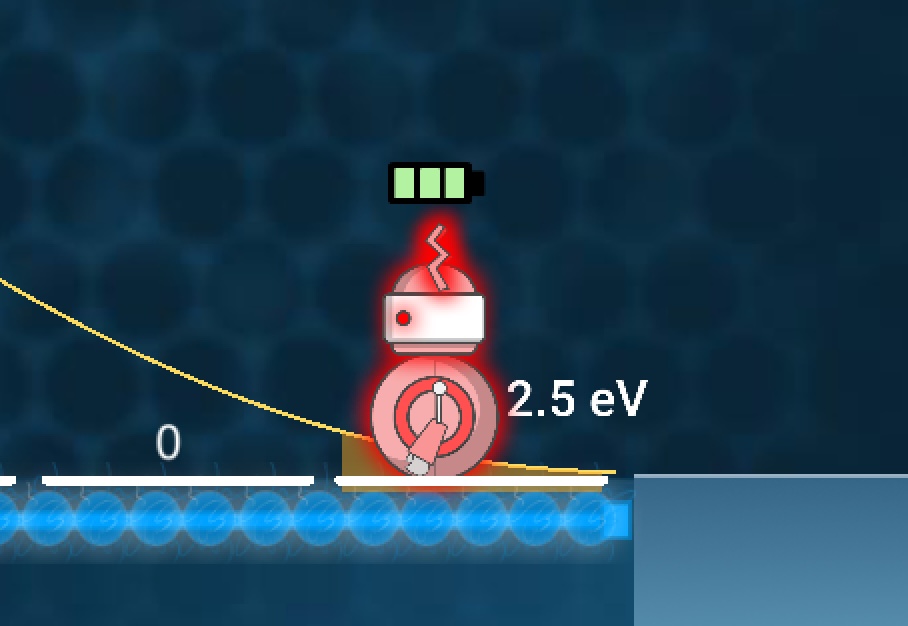
Exact Shield: The enemy bot can now only be shocked when the electron has exactly the energy equal to its shield. Not more, not less.
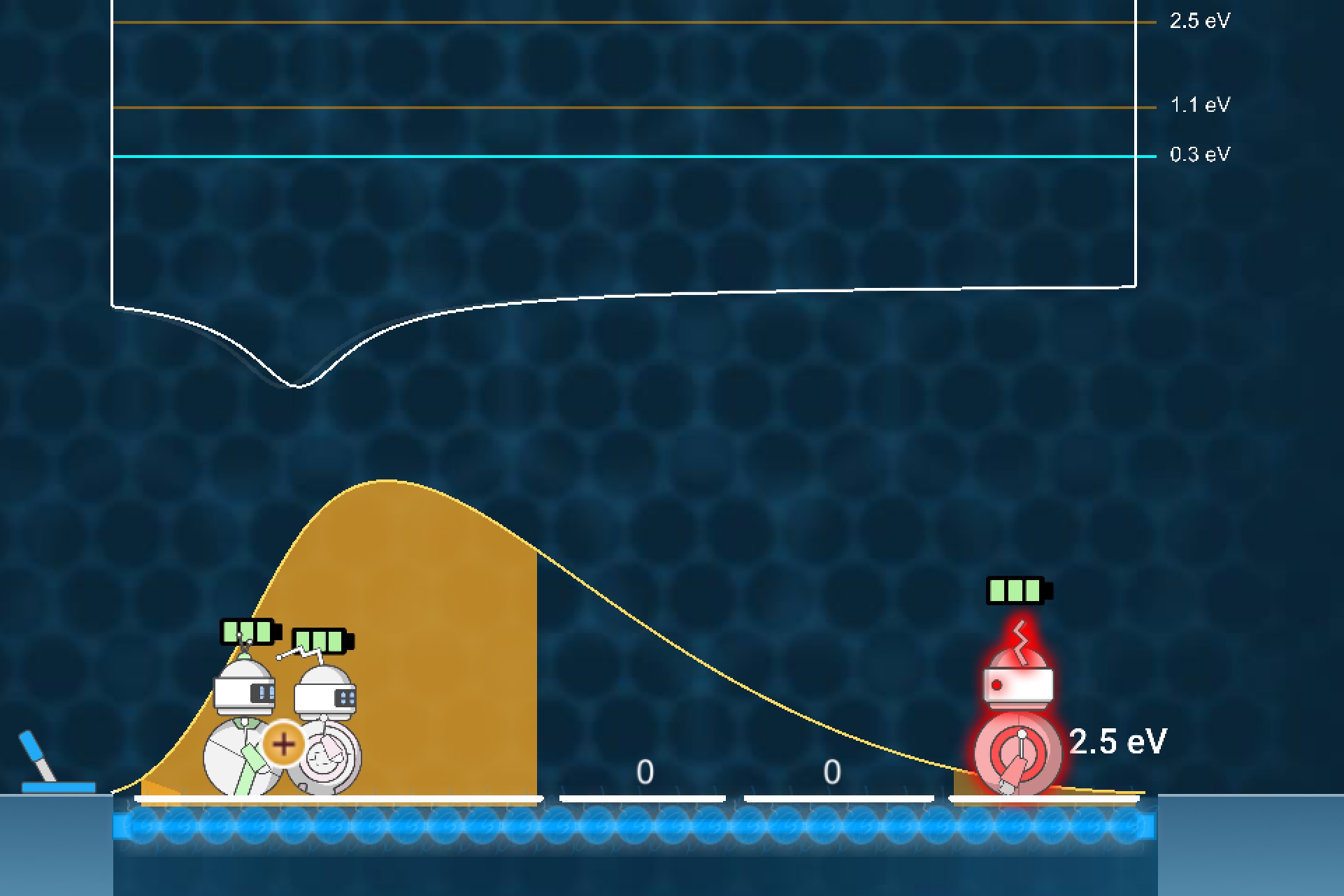
Moving Charges: Changes in the charges around the electron wire affect the potential profile, which in turn affects the energy levels. Players have to move together to pick up and carry around a positive/negative charge until they find an energy level that is exactly equal to the enemy’s shield (3 ev here).
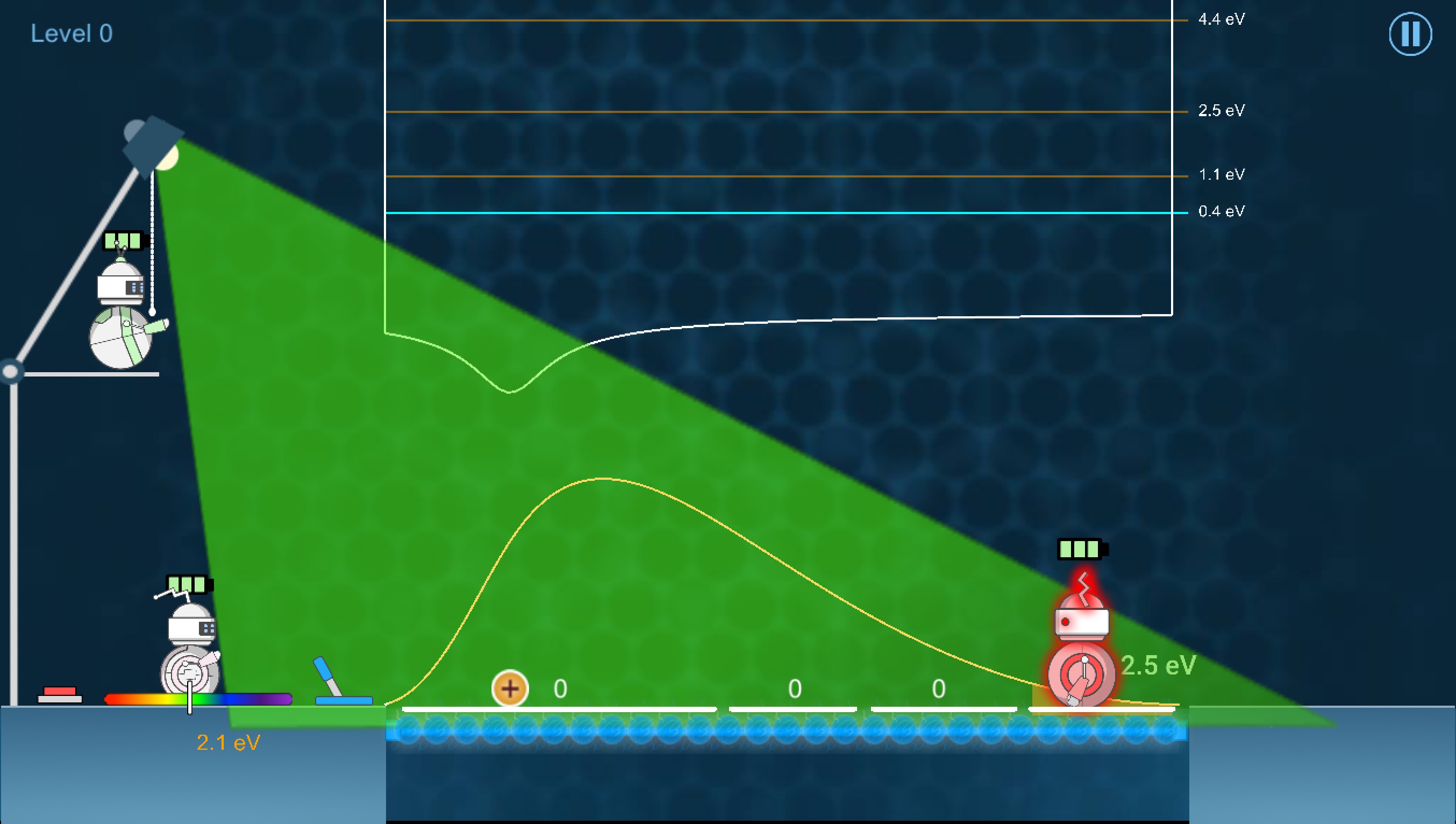
Shining: They then have to shine light of the correct color to increase the electron's energy to that energy level, so that will it have the exact energy to knock out the enemy robot's shield when measured.
(Video) Observing, Moving, Shining, Repeat!: As players move the charges around, it changes the gaps between different energy levels as well as the shape of the probability distribution function (p.d.f). So now players have to lure and shock the enemy bot to different spots depending on where they moved the charges.
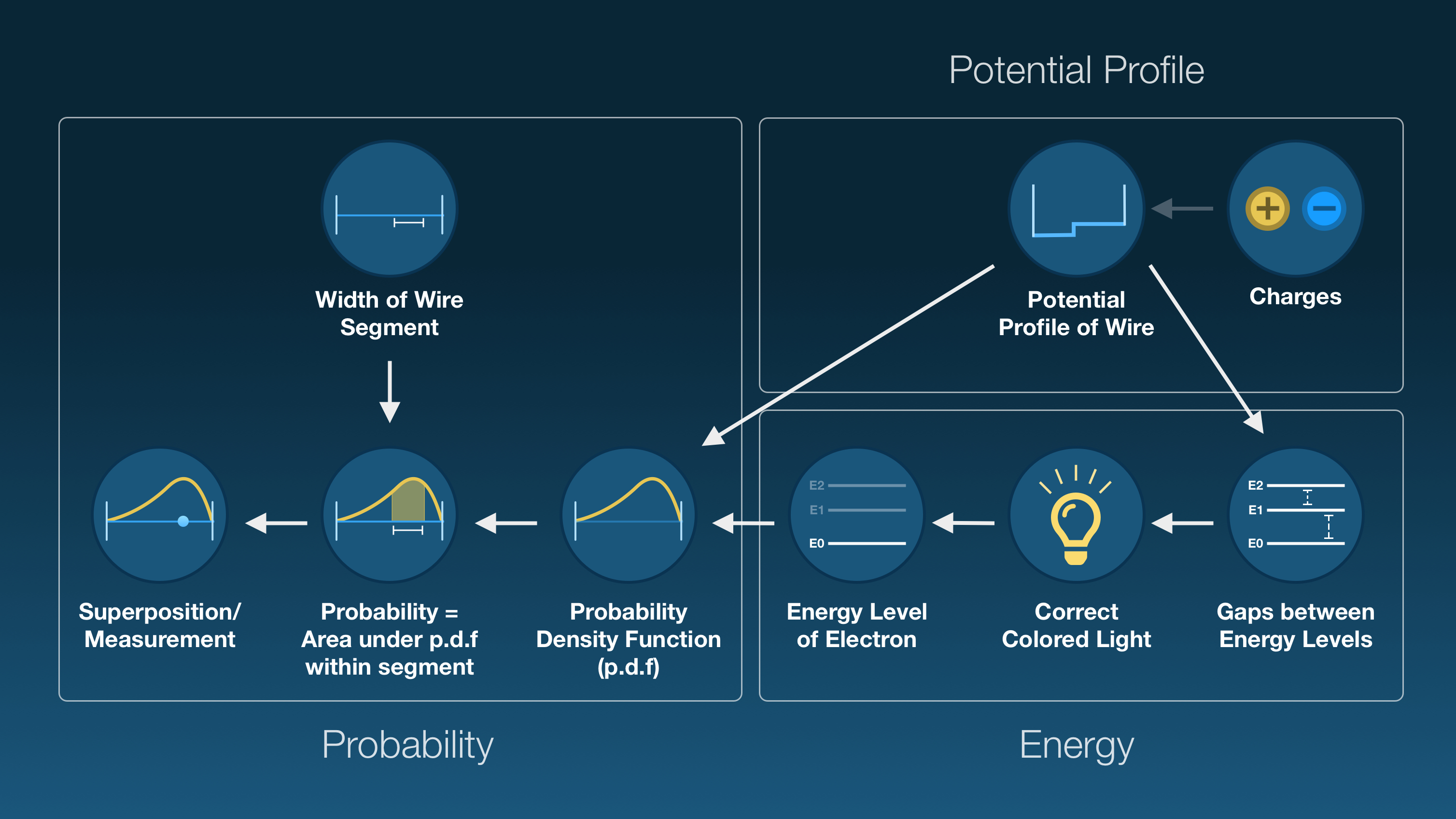
Relationship to Learning Objective 3: By moving the charges around the wire, players can observe how it affects the potential profile of the wire, which in turn affects the energy levels and shape of the probabiility distribution curve. Coupling this mechanic with the mechanics of changing energy levels and luring/shocking the enemy bot allows players to observe and experiment with the system as a whole as shown in the concept map.
Design Process/Iterations
Games
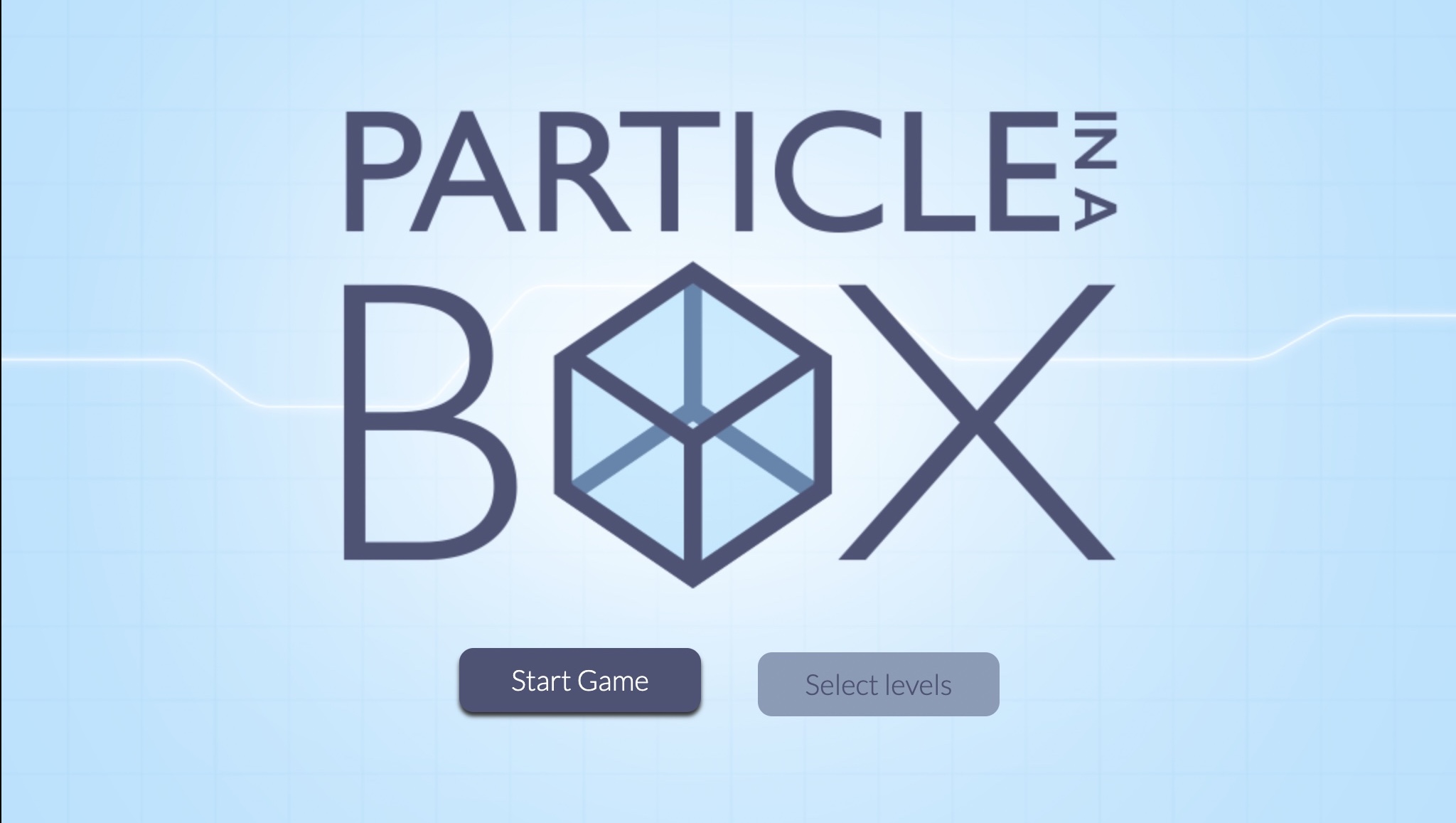
The first version of the game was built in Crafty.js and had 2 levels (1 classical, 1 quantum). It was pilot tested with undergraduate chemistry major students studying quantum mechanics.
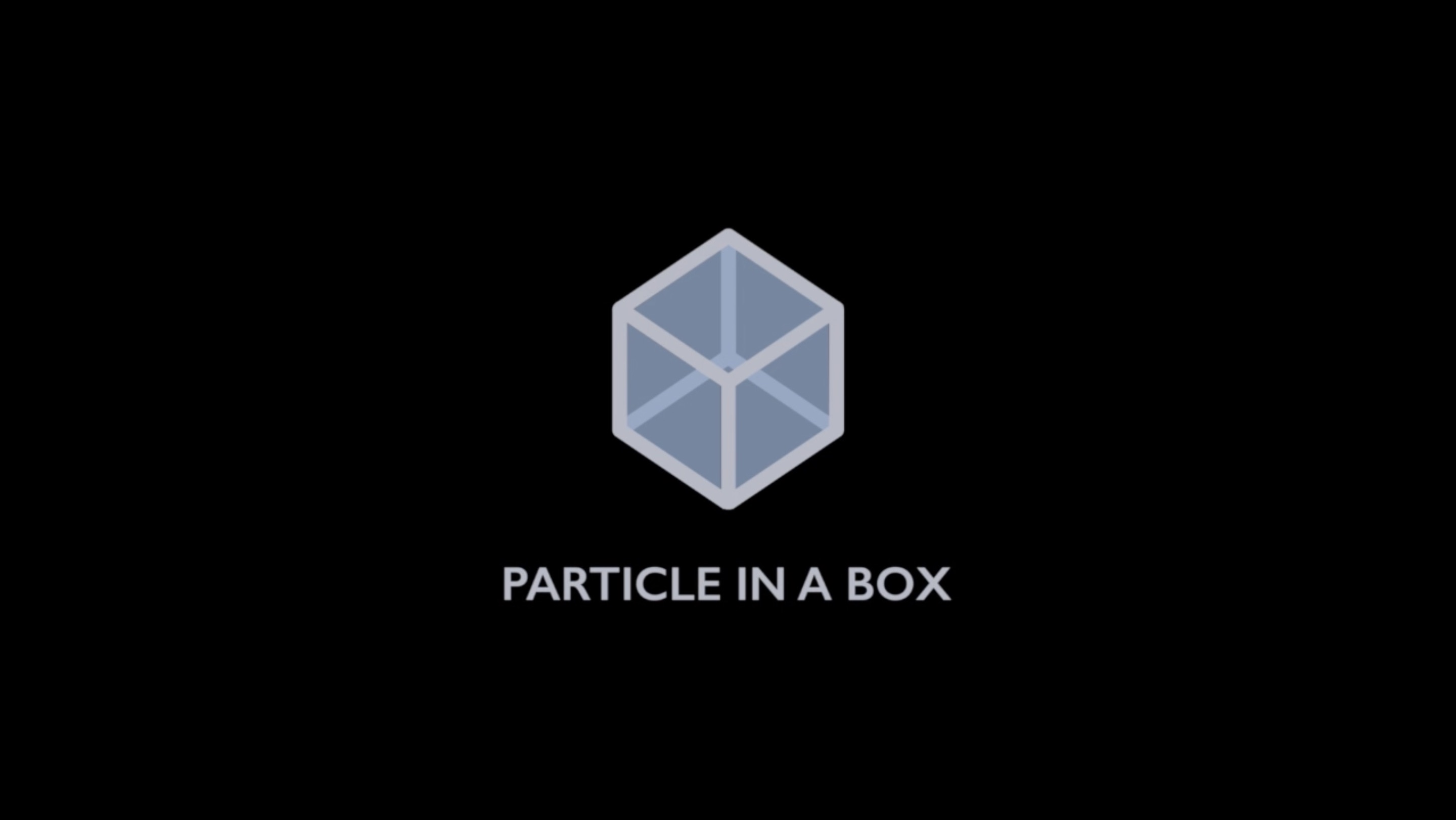
The second version of the game was built in Unity and had four levels (2 classical, 2 quantum). It drew on feedback from the pilot test to refine the mechanics and art. It was formally tested with 14 undergraduate junior electrical engineering students studying quantum and semiconductor physics.
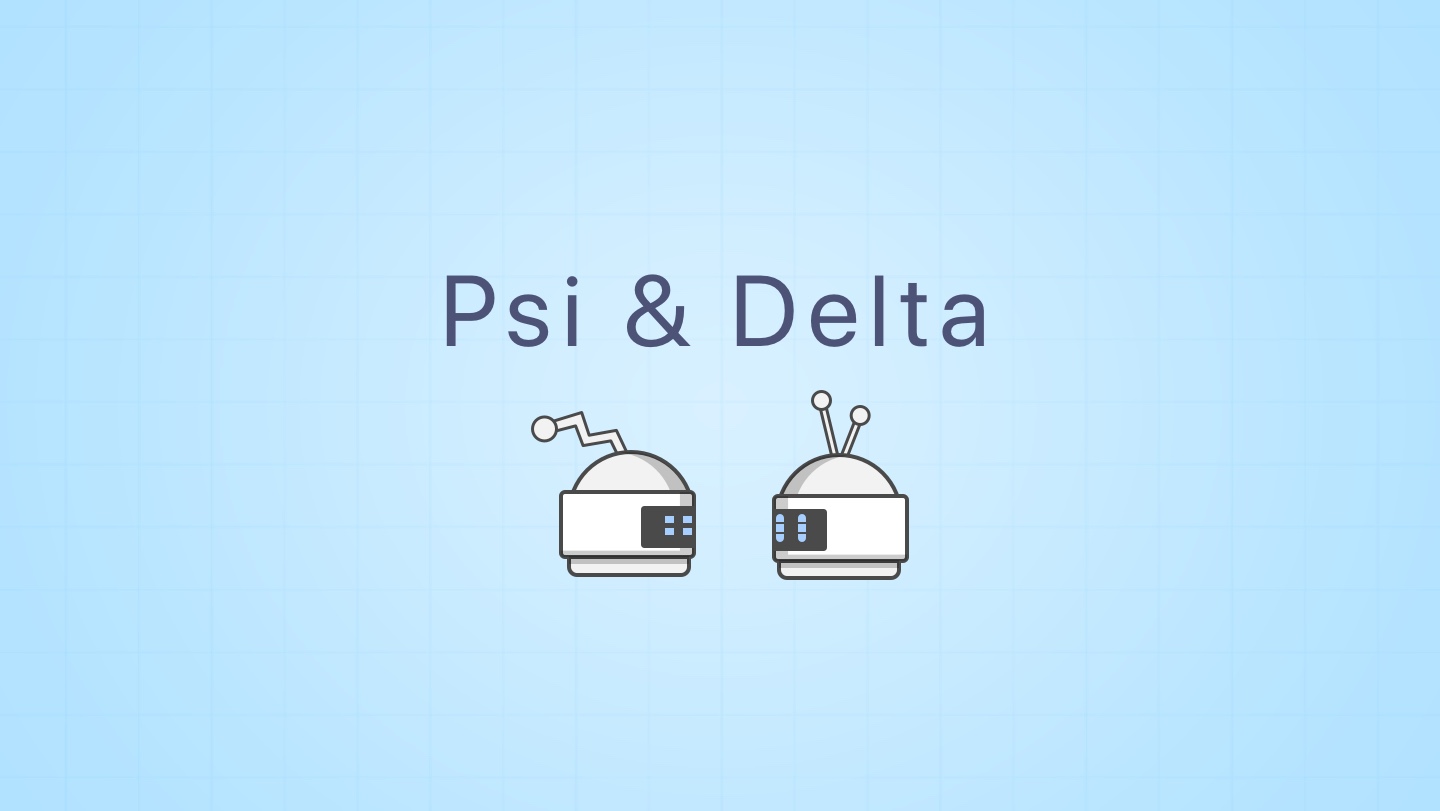
The current version of the game was also built in Unity and improved upon Particle in a Box in several ways: It added a multiplayer mode which allowed players to engage in collaborative learning; it added more levels (15 total + 2 in prog.) that habituate players to the concepts and learn more gradually; it changed the core mechanics to give players more control and learn at their own pace. These have shown promising results in our pilot tests.
Mechanics
Electron as Enemy | Only Probability
In the first version of the game, players had to bring energy bulbs to a source that would increase the electron's energy. They would have to get these bulbs while avoiding the electron which was measured automatically along the platform. Carrying longer bulbs meant being more likely to be hit by the electron. Players could stand at "nodes" where the electron cannot be measured, to be safe. Players learned probability by observing the shape of the electron's probability function (its highs and nodes) and by using it when running to gather the bulbs. However, the connection between the bulbs and the electron's energy was unclear in this version as they were all the same color.
Electron as Enemy | Probability+Energy
The second version of the game employed the same mechanic as the first. It made the bulbs have color and the energy source be a lamp that would visibly shine light on the electron wire. The problem with this mechanic more generally was that since the electron's measurement was automatic and probabilistic, players would grow frustrated at being powerless (especially since they could not jump). They could not do much other than run and hope they don't collide into the electron. While this frustration was valuable in helping players understand the probabilistic and pseudo-random nature of electrons, it also detracted from the learning.
Electron as Aide | Probability+Energy
The third version of the game changed the mechanic to allow players to take measurements on their own terms to shock an enemy robot. It also allowed them to jump. This gave them more control and turned the electron from an enemy into an aide to be employed strategically in conjunction with QM concepts.
Tutorials
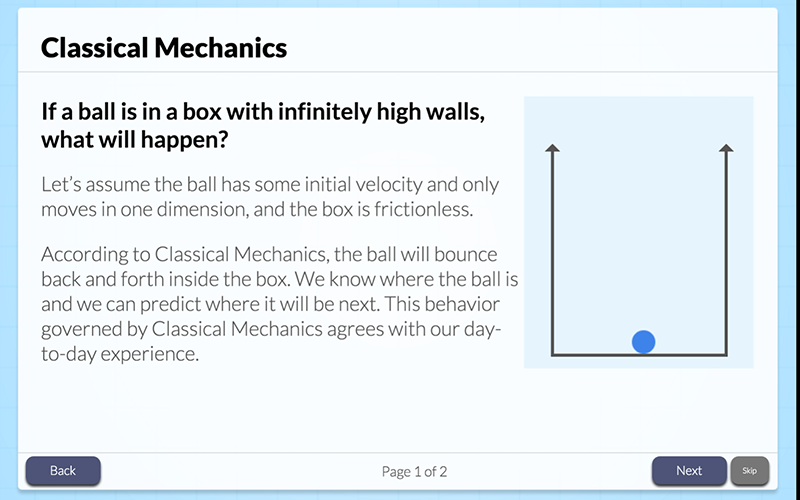
Tutorial: Pages
The first iteration required the player to read a few pages of text before starting each level. We found players often skipping these as they desired to jump straight into the game. This resulted in less effective learning.
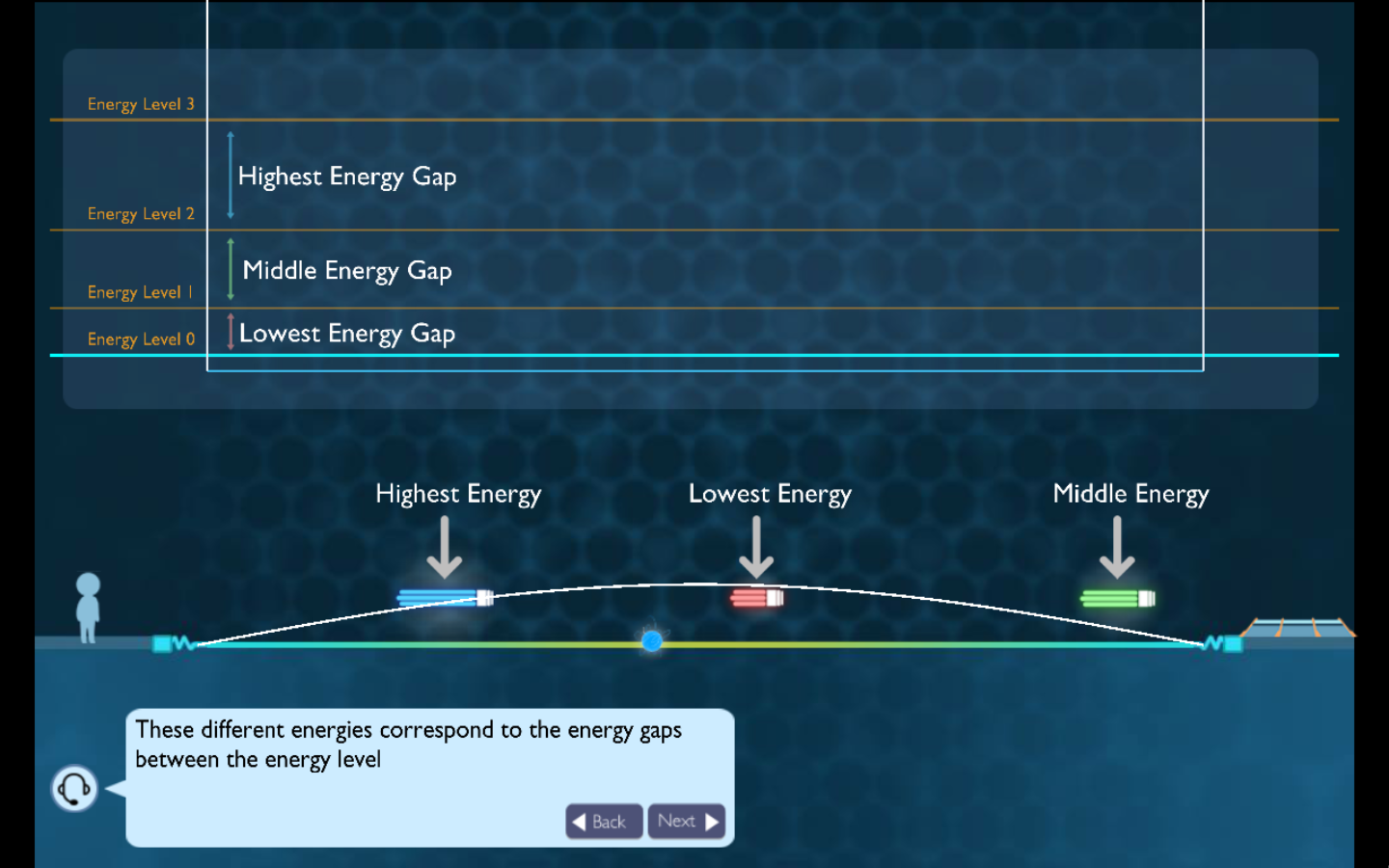
Tutorial: Textbox
The second version's tutorials took the form of a text-box at the bottom of the level's screen that gave players instructions step-by-step. Players could not move until they had finished reading the text. This again resulted in players quickly hitting "next" until they finished the instructions, skipping important concepts.
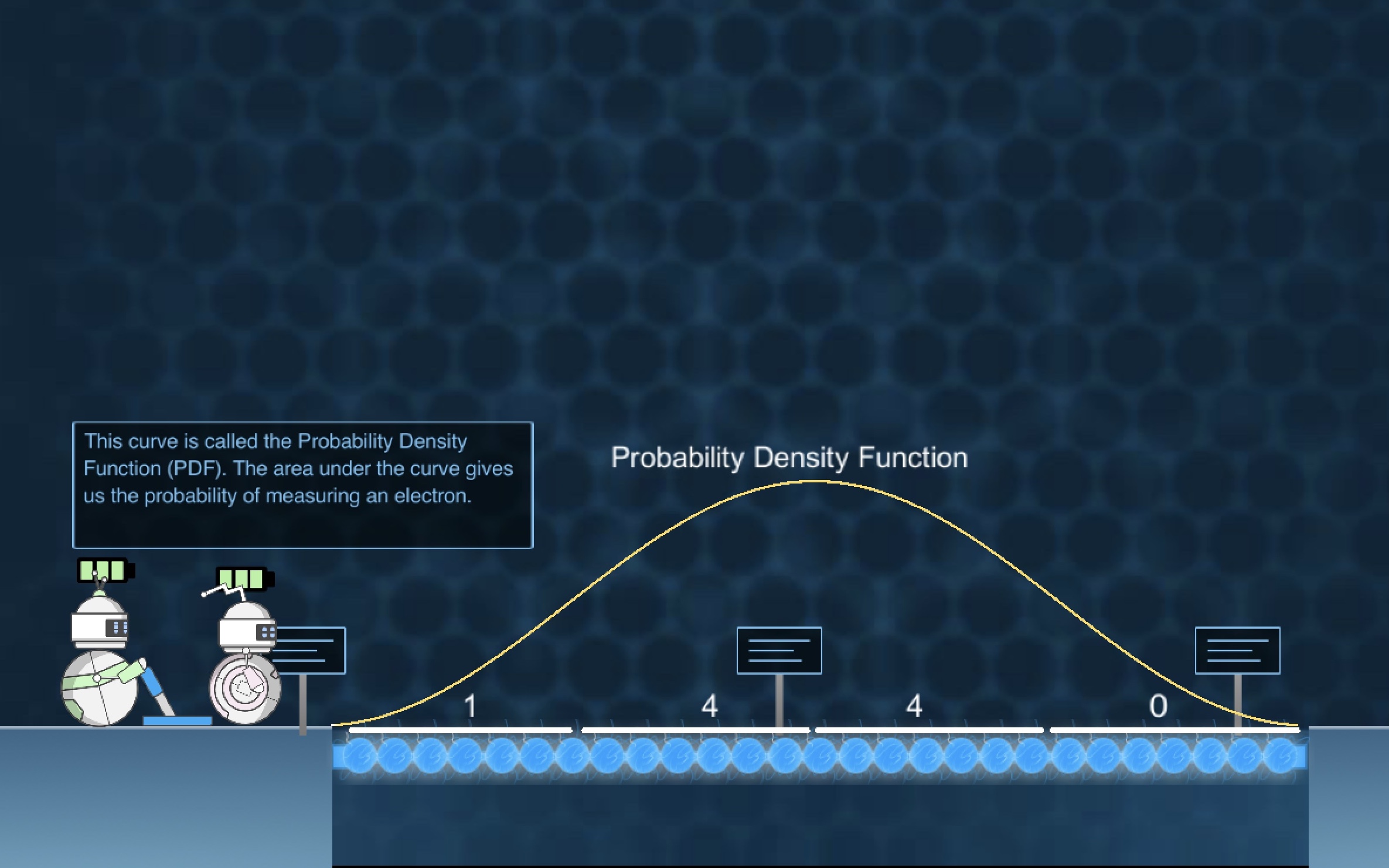
Tutorial: Signpsots
Psi and Delta's tutorials took the form of "signposts" that popped up key information when players walked up to them. This approach gave control of the game to the players immediately and let them learn at their own pace rather than a fixed pace, improving learning.
Character Design
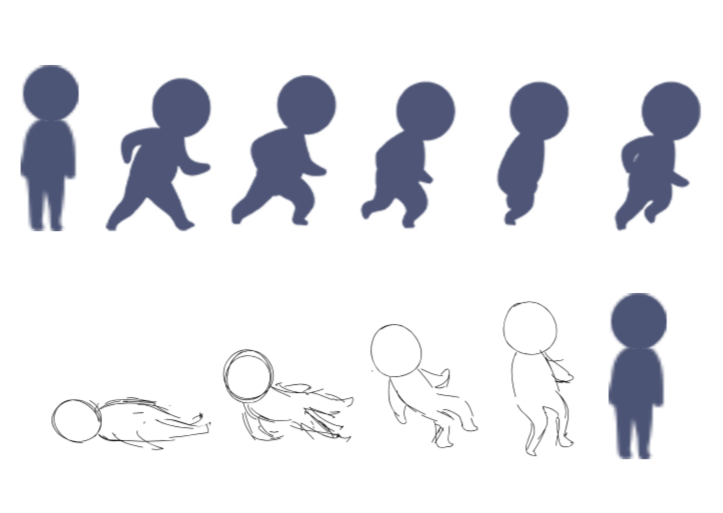
(initial humanoid character)
Our first approach to this challenge was to create an abstract character with few expressive details. We reasoned that a minimalist character design would limit its association with any particular identity. However, our evaluations indicated that in spite of having child-like proportions and relatively abstract embodiment, the character was interpreted as male. Further, the abstractness left players without any special attachment towards it.
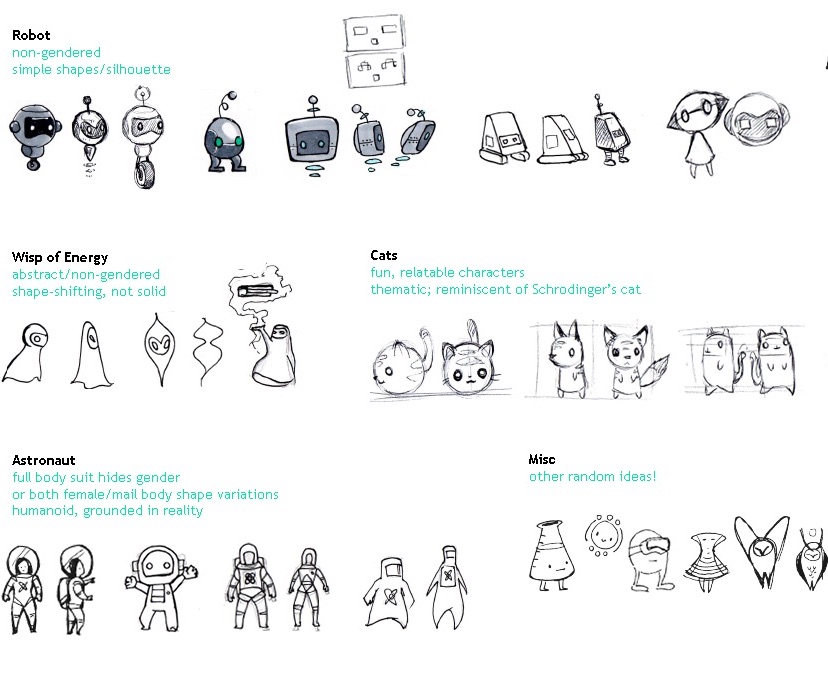
The second possibility that we explored was to design non-human characters. Although no character design can be free from assumptions and bias, we posited that human characters amplify biases such as gender and race more than non-human characters. Our initial explorations of non-human characters consisted of animals, objects, robots and even wisps of energy.
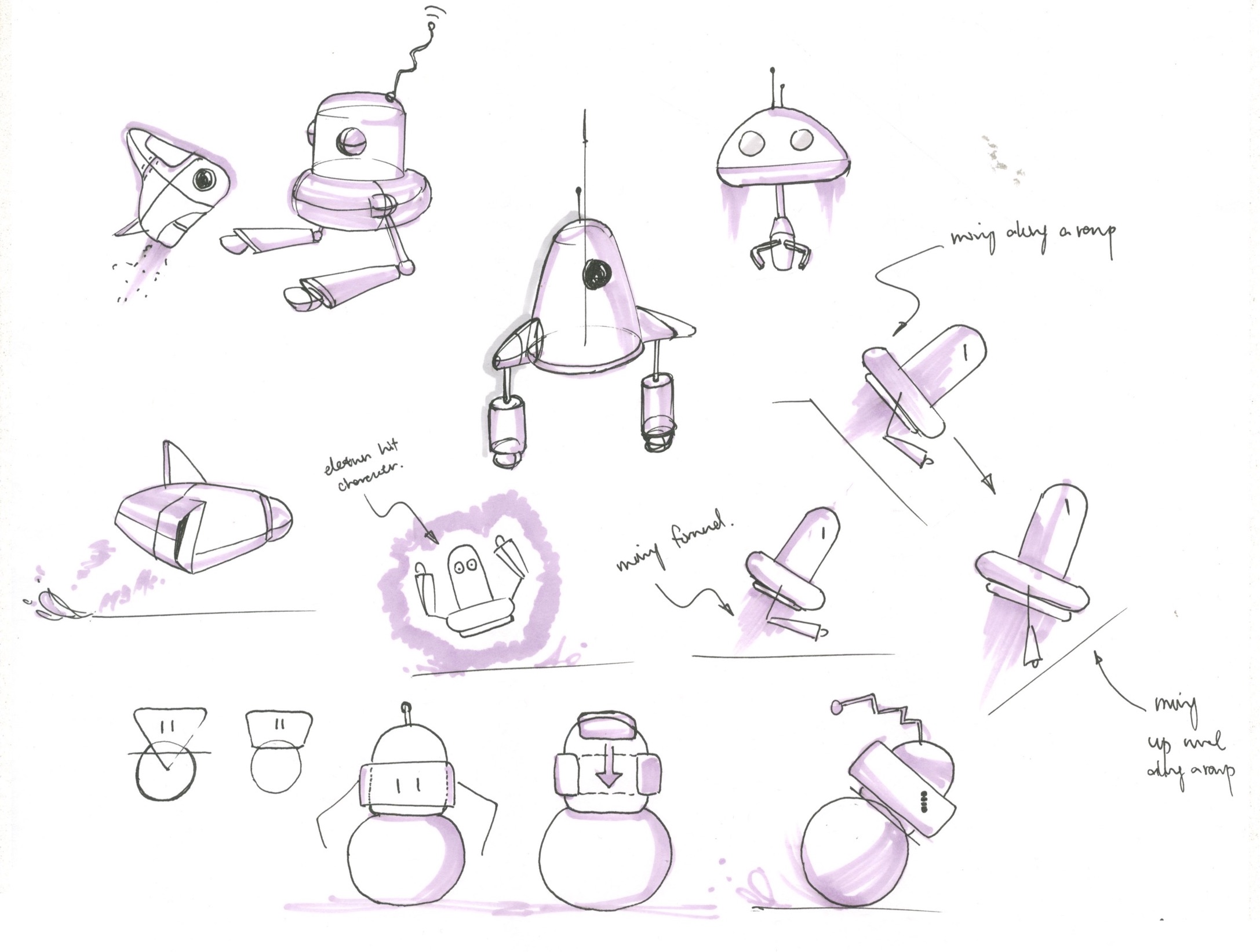
Compared to other options the robot was simpler to explain as a character that can move around in the quantum world (like a nanobot). We hypothesized that players would be more willing to suspend disbelief and accept a robot in the quantum world than any other character. This is because robots are frequently referenced in popular culture (e.g., in science fiction series like Star Wars), where they perform activities that humans usually cannot do. This made adding features to the character much simpler as they would just be accepted as “something robots can do.”
